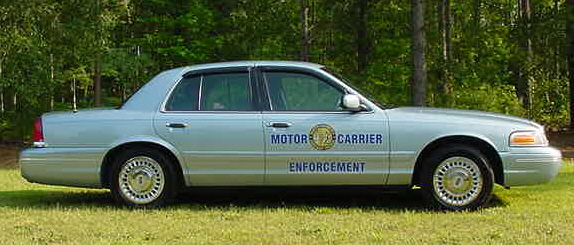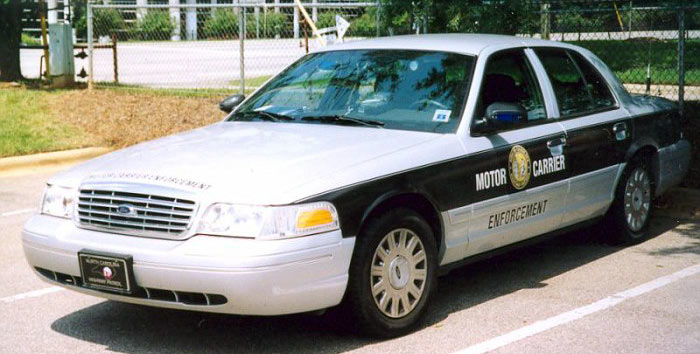North Carolina Highway Patrol 
North Carolina Highway Patrol 
In 1929 alone, the Tarheel State saw 690 motor vehicle fatalities on the state's roadways and highways. Traffic control was of such concern that in 1929 the General Assembly passed an act authorizing the establishment of a State Highway Patrol.
The new organization was given statutory responsibility to patrol the highways of the state, enforce the motor vehicle laws, and assist the motoring public. The organization was designed as a division of the State Highway Commission. The Highway Commission initially sent ten men (later designated as a captain and nine lieutenants) to Pennsylvania to attend the training school of the Pennsylvania State Police.
Their mission was to study law, first aid, light adjustments, vehicle operation, and related subjects for use in North Carolina's first Patrol School. An office was established in Raleigh to serve as state headquarters, and a district office was established in each of the nine highway districts. A lieutenant and three patrolmen were assigned to each district. All patrolmen were issued Harley Davidson motorcycles and the lieutenants drove Model A Ford Coupes.The Patrol commander was issued a Buick automobile.
The North Carolina State Highway Patrol's primary mission is to reduce collisions and make the highways of North Carolina as safe as possible. Since 1929 the mission of the Highway Patrol has not changed. From a handful of Highway Patrolmen in 1929 the Highway Patrol now employees 1,455 troopers and 365 Motor Carrier officers to cover more than 78,000 miles of North Carolina roadways.
In 2004, the State Highway Patrol arrested 26,005 people for driving while impaired, seized $10 million worth of drugs, and investigated 1,119 fatal collisions on North Carolina highways. The Motor Carrier unit fined thousands of truck drivers for various violations. Troopers and Motor Carrier Enforcement officers also guide traffic during hurricane evacuations or re-route traffic around hazardous chemical spills. The Patrol stands ready, should any act of terrorism occur, to carry out the directives of the Governor. The Highway Patrol has eight Troop locations throughout the state.
The earliest known license plates used by the NCHP were those issued in 1935 for the agency's fleet of new convertibles. The plates were made of embossed steel and measured approximately 5 1/2 inches by 12 inches and were painted in silver over black. The prefix SHP was used followed by a dash and a three digit number believed to have begun at number 100. The state name was spelled out in full along the bottom of the plate.
In 1936, the plates continued with the SHP-### format on the same sized plate but this time embossed on aluminum rather than steel.
the color scheme was dark blue over aluminum with the state name embossed along the the top of the plate. It has also been stated that for some of thse plates, the year "36" which was embossed in the top right corner of the plate for other motor vehicles in the state, was hammered-out flat to make this plate valid for several years. These plates were intended to be run for several years and in some cases may have, however a 1937 photo clearly shows a marked NCHP car bearing regular passenger license plates instead.
It has been stated by Tar Heel State old-timers that the 1936 SHP license plates were re-used very often including up into the 1960's !
Confirmed "survivors" for the 1936 base plate are SHP 166, 237, 264, 285, 325 and 367.

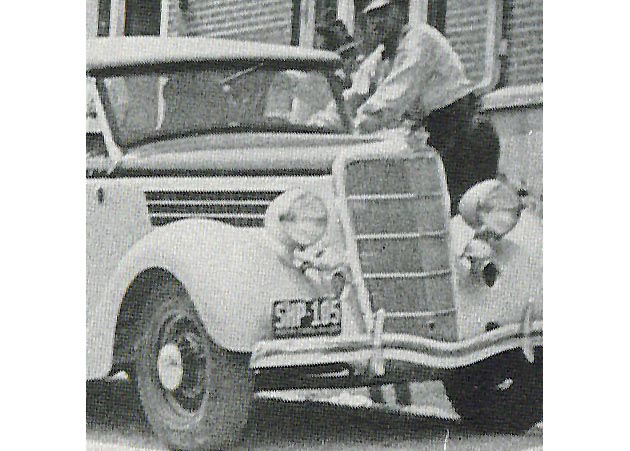 1935-earliest NCHP type known
1935-earliest NCHP type known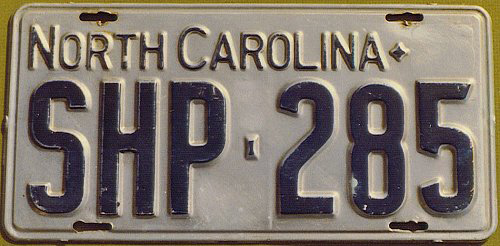 1936 (-1940) issue.
1936 (-1940) issue. 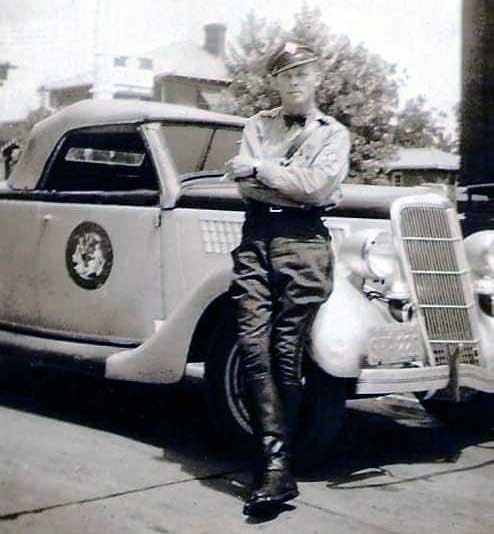 1936
1936As seen in the photo below, a marked NCHP car is sporting a 1937 North Carolina passenger car license plate number 358-735. This creates a query, as the 1936 SHP prefixed plate decribed above was supposed to be a multi-year usage plate for the Patrol. Therefore, either the passenger plate seen for 1937 was a "one-off", or the passenger plates were used in conjunction with the SHP multi-year plates. More evidence is needed to be certain.
It can be surmised based on the lack of data, that for several years up to 1945, that the NCHP issued passenger series license plates for its patrol fleet.
The SHP prefix for NCSHP vehicles was used again in 1946 and 1947 with current "survivors" known, however all other indicators beyond 1947 indicate a return to passenger license plate use as a majority beyond the 1936 "multi-year" SHP license plates being re-issued while sill legible.
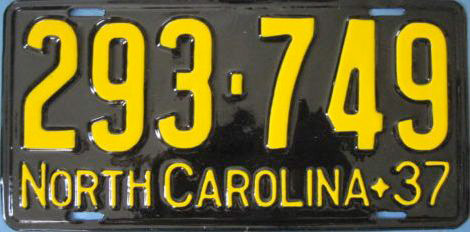 1937 passenger issue. Embossed steel.
1937 passenger issue. Embossed steel.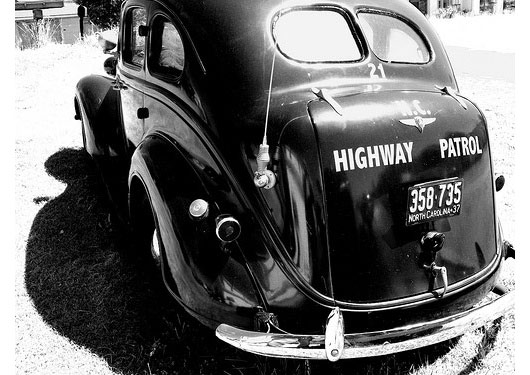 1937- Using passenger series license plate.
1937- Using passenger series license plate.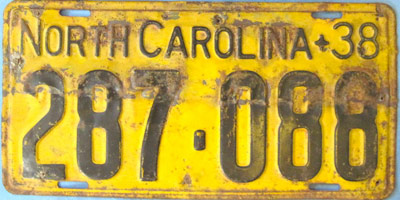 1938 passenger issue. Embossed steel. 1938 passenger issue. Embossed steel.Black over yellow-orange. |
 1939 passenger issue. Embossed steel. 1939 passenger issue. Embossed steel.White over red. |
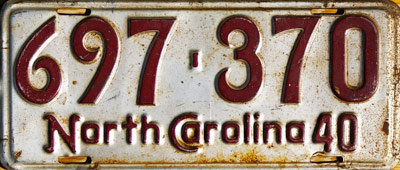 1940 passenger issue. Embossed steel. 1940 passenger issue. Embossed steel.Maroon over silver. |
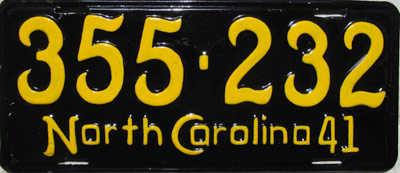 1941 passenger issue. Embossed steel. 1941 passenger issue. Embossed steel.Yellow-orange over black. |
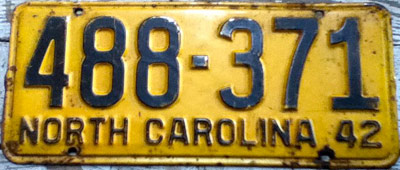 1942 passenger issue. Embossed steel. 1942 passenger issue. Embossed steel.Black over yellow-orange. |
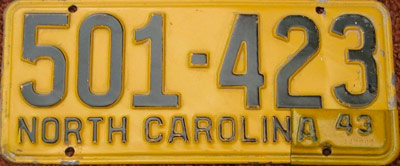 1943 passenger issue. Embossed steel tab. 1943 passenger issue. Embossed steel tab.Black over yellow-orange. |
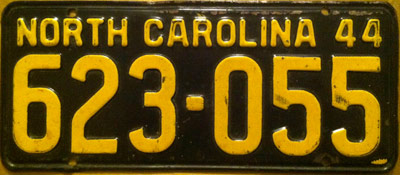 1944 passenger issue. Embossed steel. 1944 passenger issue. Embossed steel.Yellow-orange over black. |
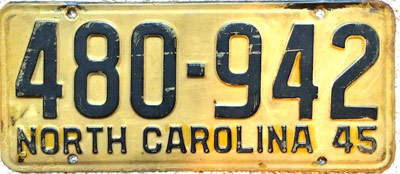 1945 passenger issue. Embossed steel. 1945 passenger issue. Embossed steel.Black over yellow-orange. |
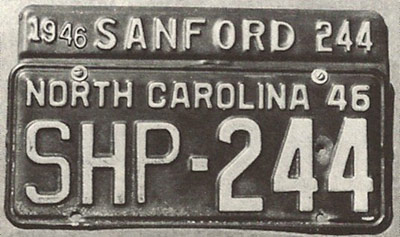 Return of SHP prefix. Return of SHP prefix.Yellow-Orange over black Matching county tab shown. |
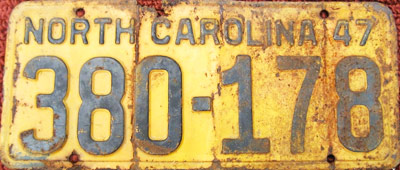 1947 passenger issue. Embossed steel. 1947 passenger issue. Embossed steel.Black over yellow-orange. |
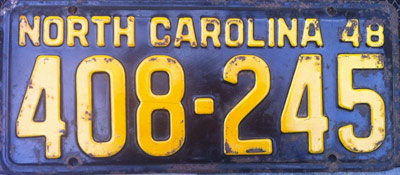 1948 passenger issue. Embossed steel. 1948 passenger issue. Embossed steel.Yellow-orange over black. |
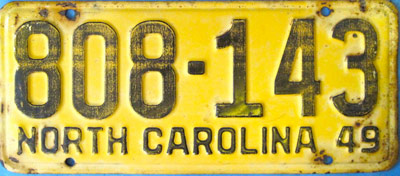 1947 passenger issue. Embossed steel. 1947 passenger issue. Embossed steel.Black over yellow-orange. |
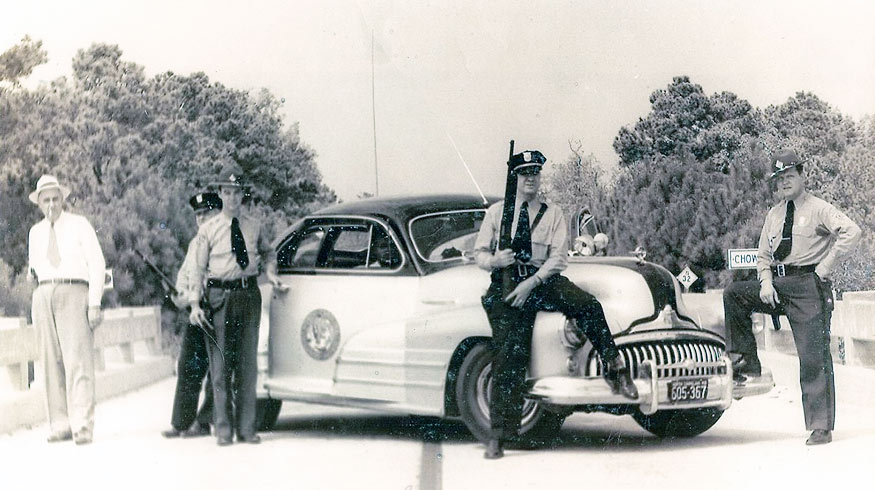 1948- Road Block. 1948- Road Block.(Courtesy Anthony Barnes) |
||
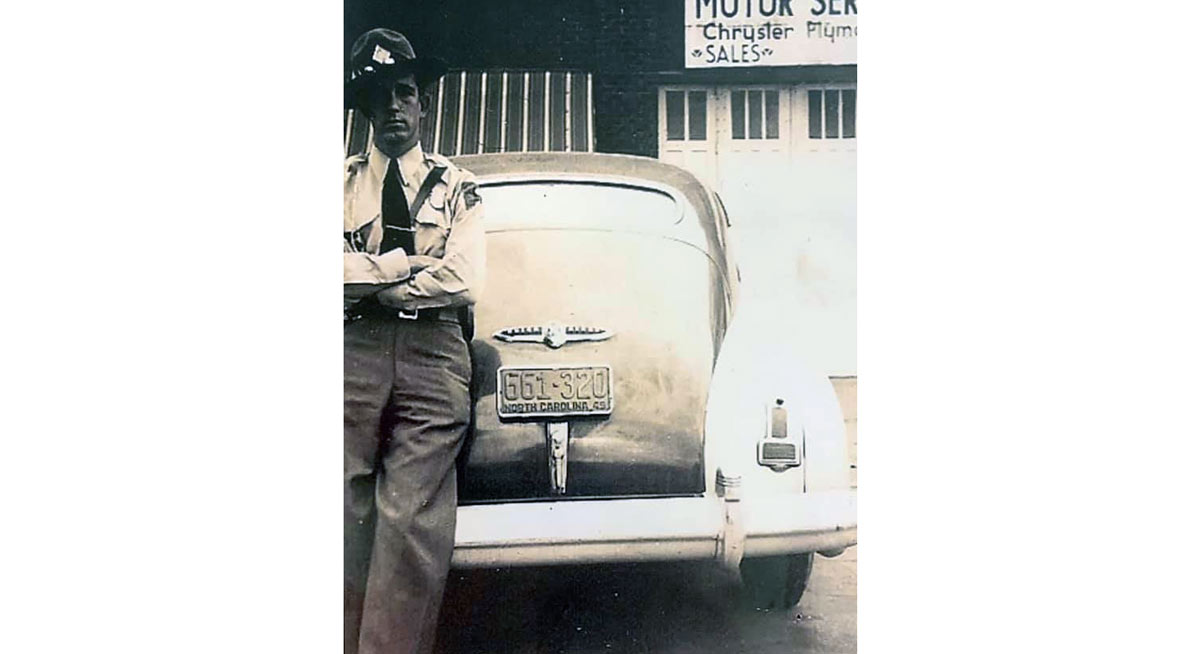 Patrolman Clyde R. Shook in Wilkesboro 1949. Patrolman Clyde R. Shook in Wilkesboro 1949.Regular passenger series license plate # 661-320. (Courtesy Hunter Simmons via NCSHP Sgt. David Williams) |
||
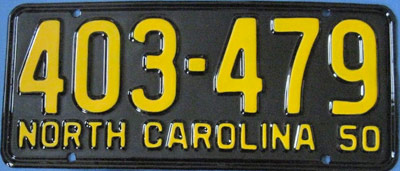 1950 passenger issue. Embossed steel. 1950 passenger issue. Embossed steel.Yellow-orange over black. |
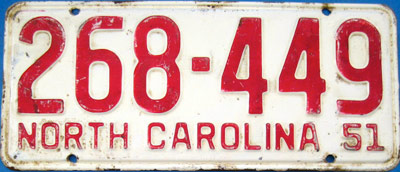 1951 passenger issue. Embossed steel. 1951 passenger issue. Embossed steel.Red over white. |
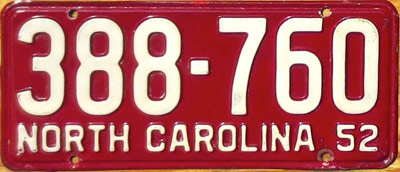 1952 passenger issue. Embossed steel. 1952 passenger issue. Embossed steel.White over red. |
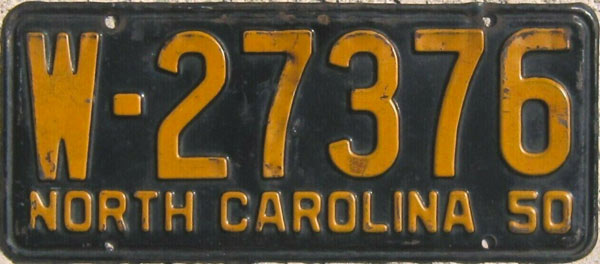 1950 W prefix overflow passenger series. Embossed steel.
1950 W prefix overflow passenger series. Embossed steel.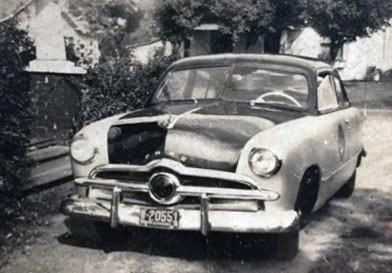 1950- W prefix overflow passenger series in use by NCSHP
1950- W prefix overflow passenger series in use by NCSHP 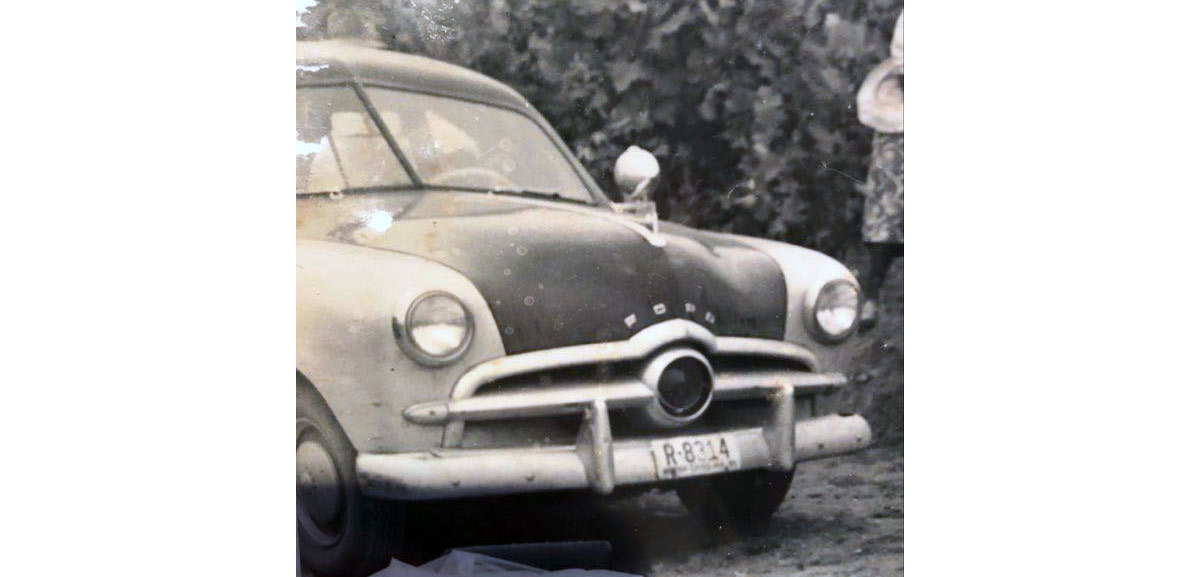
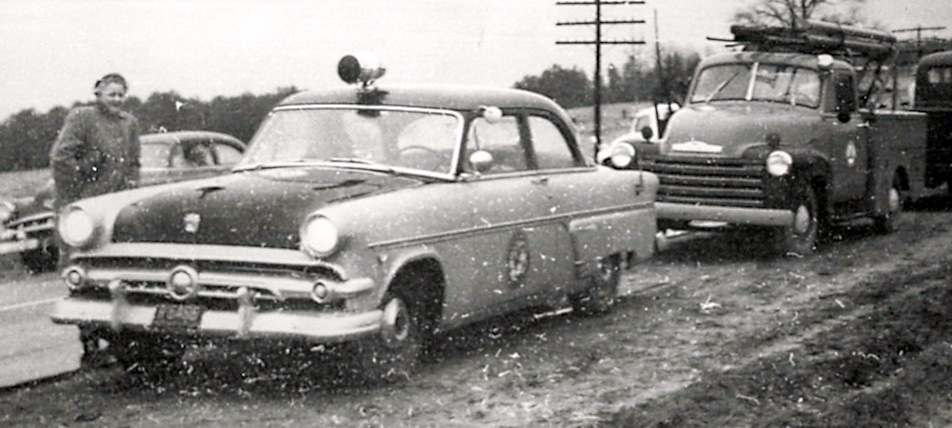
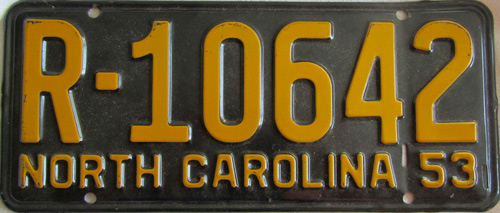 1953 passenger issue.
1953 passenger issue. 
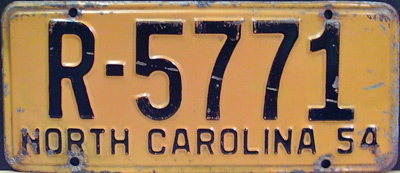 1954 passenger issue.
1954 passenger issue. 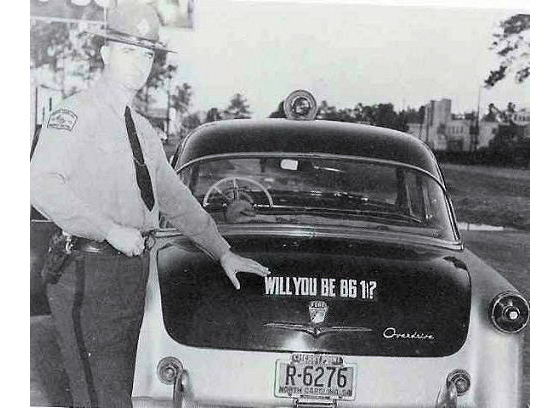 John T. Jenkins (1954)
John T. Jenkins (1954) 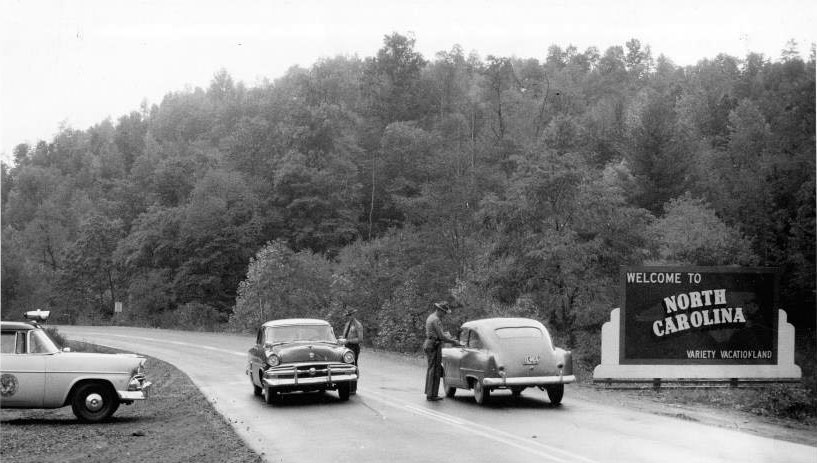 1954 Checkpoint at State Line
1954 Checkpoint at State Line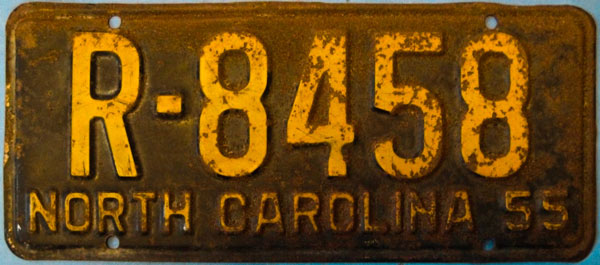 1955 passenger issue.
1955 passenger issue. 
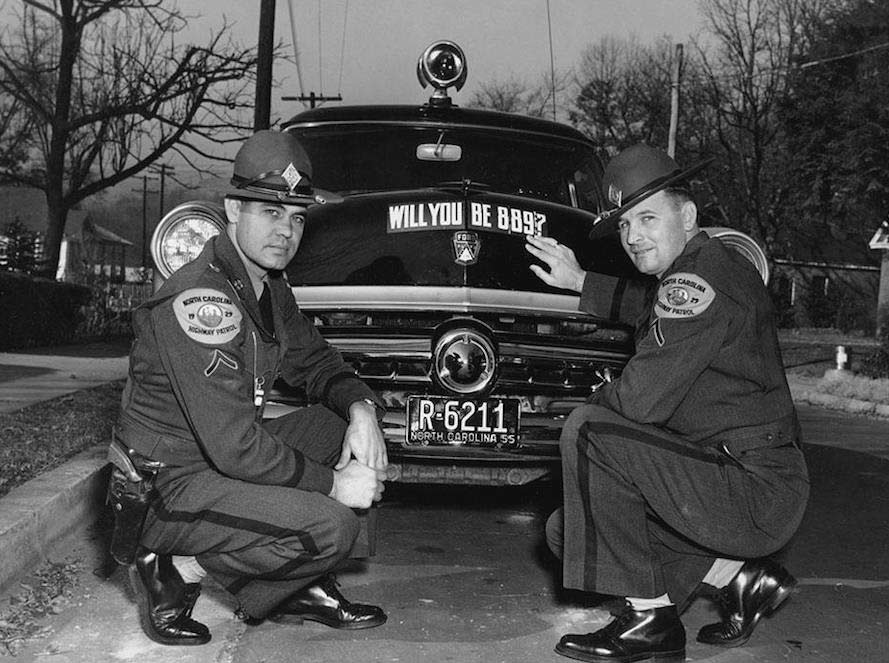 1955
1955 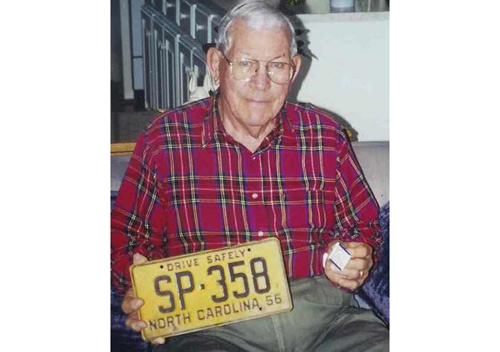 Retired NC Tpr. Francis Coleman Simmons with 1956 SP prefix plate.He served valiantly from 1951 to 1981
Retired NC Tpr. Francis Coleman Simmons with 1956 SP prefix plate.He served valiantly from 1951 to 1981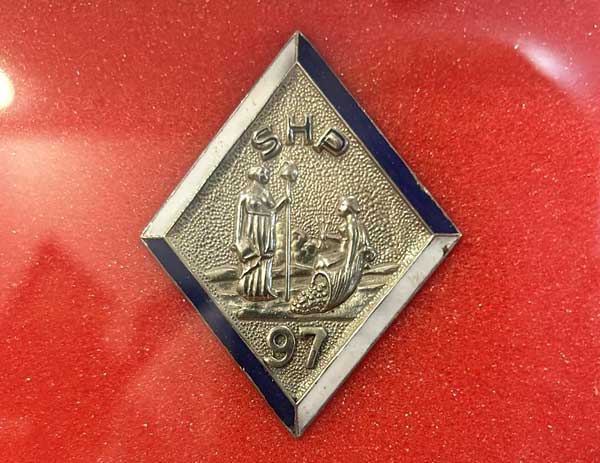 NCSHP hat badge #97 seen at left assigned to Francis Coleman Simmons
NCSHP hat badge #97 seen at left assigned to Francis Coleman Simmons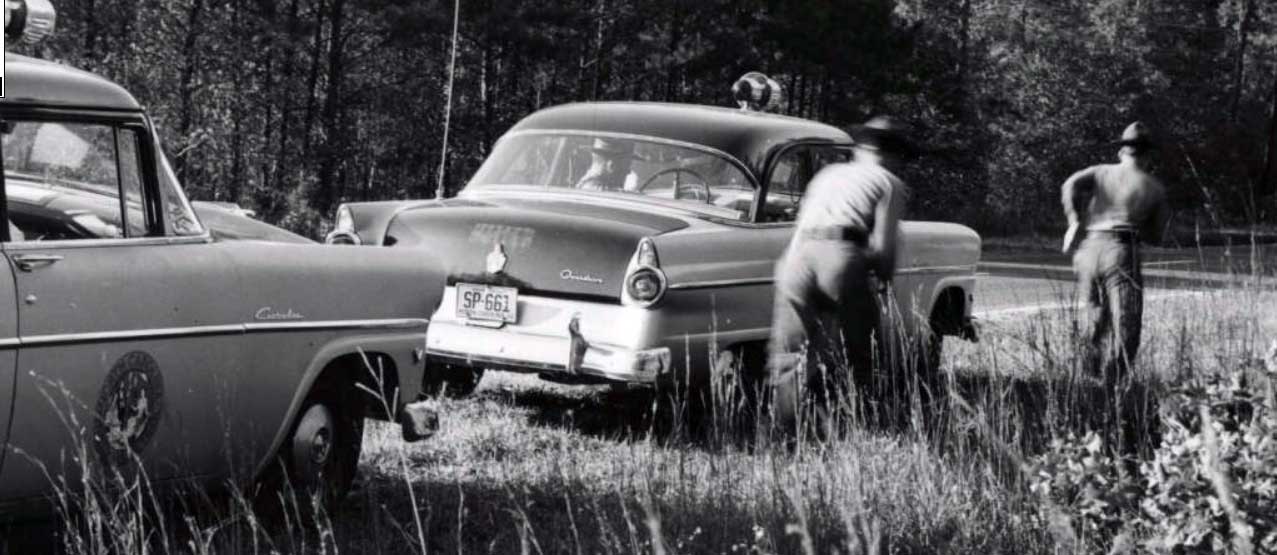 1956 (SP-661)
1956 (SP-661)  1956 (SP-130)
1956 (SP-130) 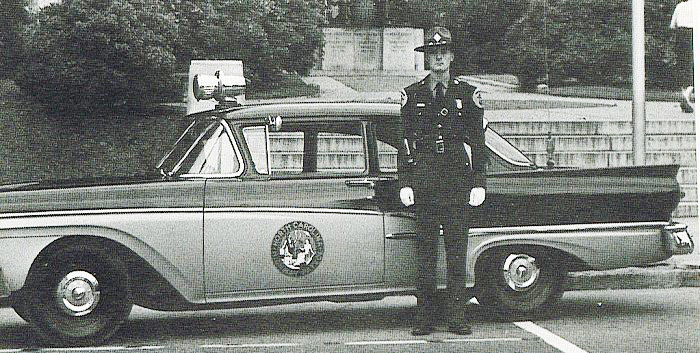
The clearest information to date on early NCHP license plates began in 1956. A NCHP Trooper by the name of F. Coleman Simmons made a habit of keeping the license plates issued annually to his patrol car from his first year of service until his retirement. It gives a glimpse into a very obscure era of NCHP license plate use as so few "on duty" photographs showing license plate issuance (rear of vehicle only) exist and no real records of issuance were retained.
Based on the Simmons collection and the recollection of other retirees from the era, annually issued plates from 1956 until 1976 were regular passenger series plates issued in a "bloc" of letter and letter combination prefixes followed by a number of mostly 3 but sometimes 4 digits.
The license plate prefix letter blocs varied from year to year depending on which local issuing agency generated the bloc.
As for the numbers during that time, some retirees recall the numbers being issued based on district, rank and seniority. Others advise that the same number was the radio number for the officer.
For example, one retiree remembered the 1967 issue as the NK letter combination prefix with the first number indicating the district number, the second number indicating the rank (2 for Sergeant and 3 for Trooper) and the third number being the assignment number. Hence a 1967 NCHP license plate with number NK 338 (as seen below from the Simmons collection) would indicate a District 3 Trooper number 8 on the seniority list. It would also be radio call number 338.
A closer look at all the F. Coleman Simmons collection would indicate that although this MAY have been true for 1967, the 1968 plate (DX 3839) throws that pattern into doubt. As do the issues before and after from the fluctuation in numbers.
What we DO KNOW are the alphabetical prefix combinations...what we still don't know for certain is the meaning of the numbers during that period.
Most of the Simmons plates are in the 300 series despite his seniority as the years continued leading to his retirement.
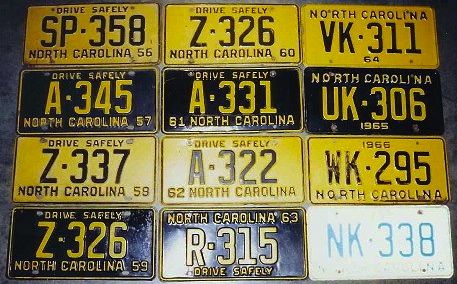
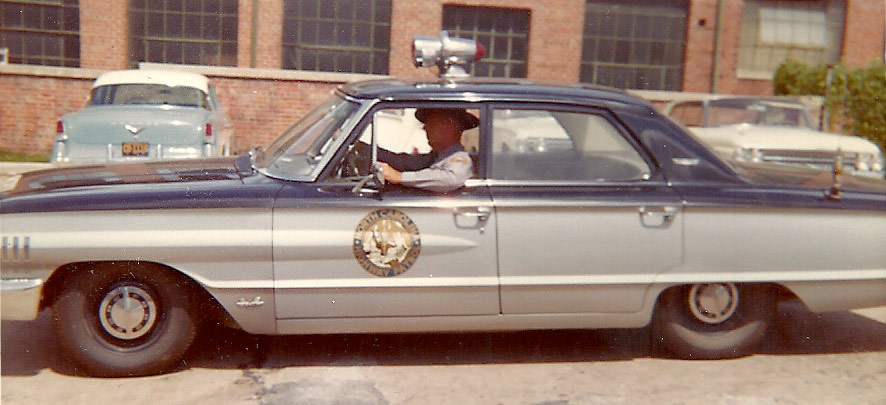
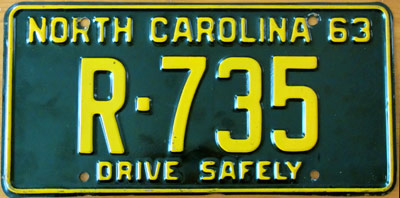 1963- Confirmed NCHP Patrol Car plate used by Trooper Jack Ferrell
Weatherly of Troop D on his 1962 Ford 4 Door. Weatherly's career with
the NCHP ran from 1962 until July 31 1991. He served at several locations
throughout the state, was an EVOC Instructor and had also served on
Governor Jim Hunt's security detail prior to retirement.
1963- Confirmed NCHP Patrol Car plate used by Trooper Jack Ferrell
Weatherly of Troop D on his 1962 Ford 4 Door. Weatherly's career with
the NCHP ran from 1962 until July 31 1991. He served at several locations
throughout the state, was an EVOC Instructor and had also served on
Governor Jim Hunt's security detail prior to retirement.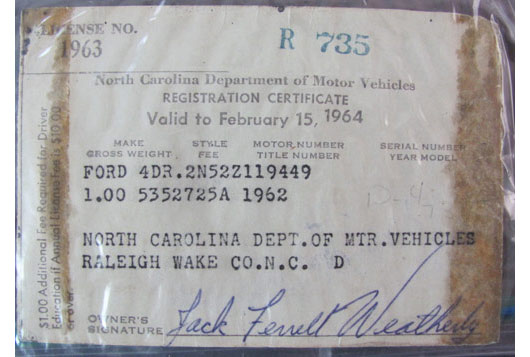 Registration slip for plate seen at left registered to Tpr. Jack Ferrell Weatherly for 1963
Registration slip for plate seen at left registered to Tpr. Jack Ferrell Weatherly for 1963
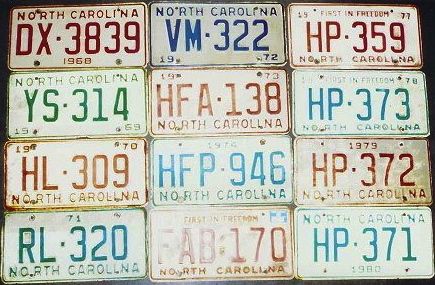
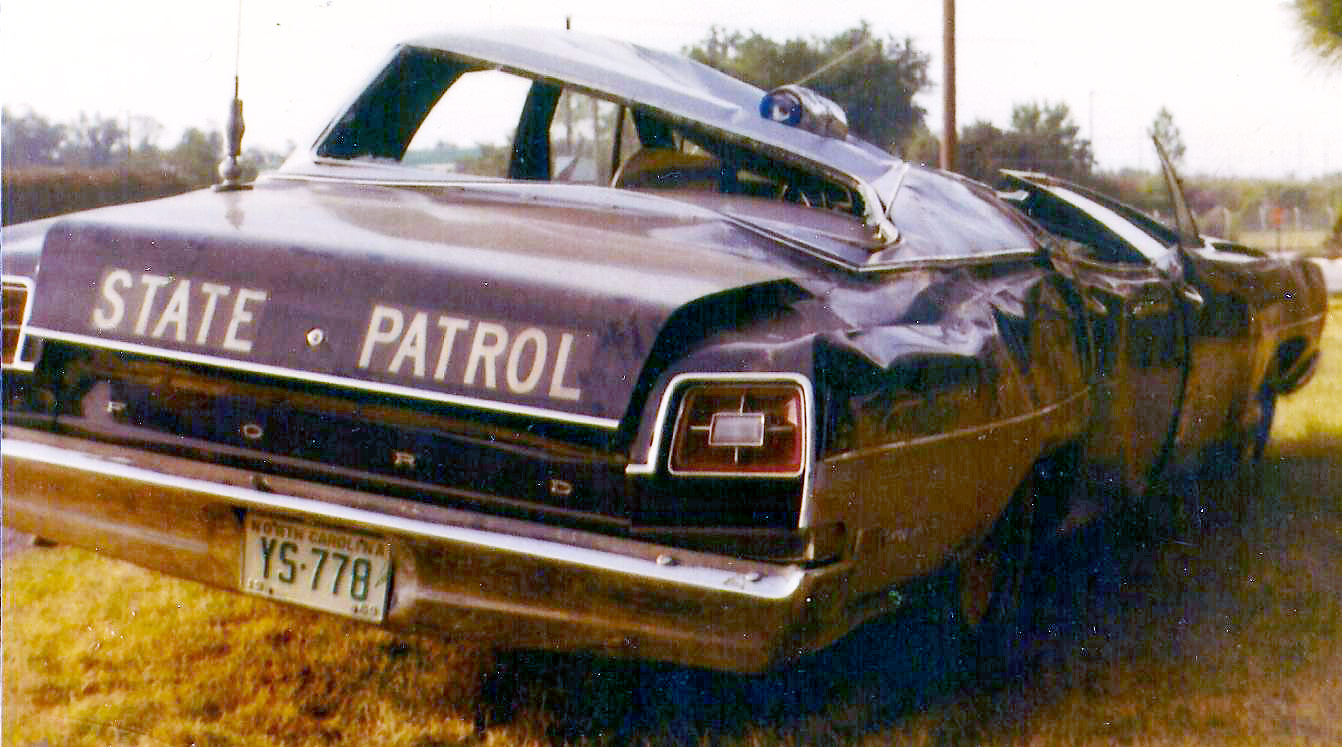
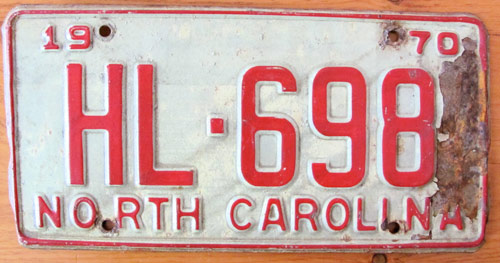 1970 issue.
1970 issue. 
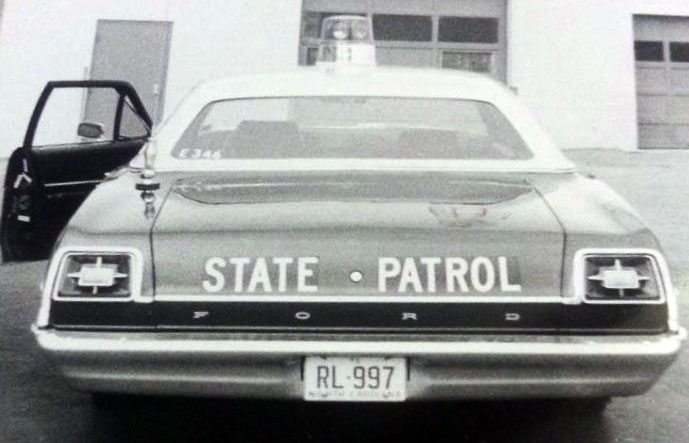 1971 issue for NCHP with RL prefix ahead of assignment number.
1971 issue for NCHP with RL prefix ahead of assignment number.
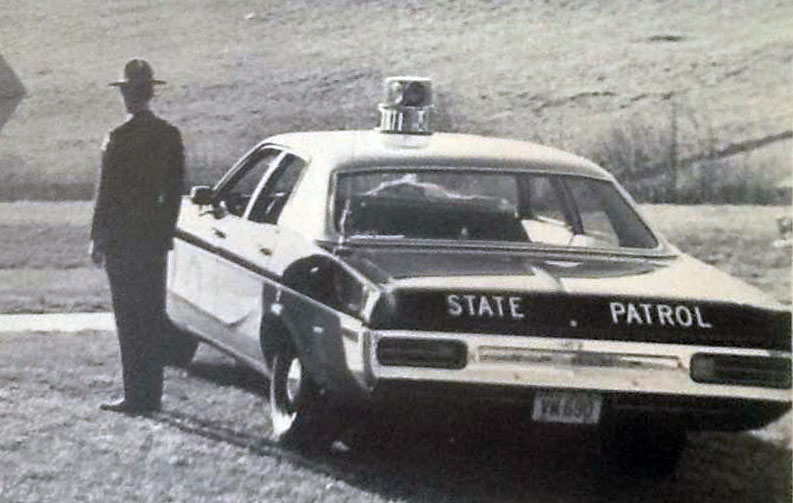 1972 issue for NCHP with VM prefix ahead of assignment number.
1972 issue for NCHP with VM prefix ahead of assignment number.In 1975, the state of North Carolina conducted a complete license plate re-issuance for the state. The new design for passenger car license plates that year was an embossed aluminum plate in red over reflective white. The top center of the plate had a new embossed slogan: "FIRST IN FREEDOM".
The registration number consisted of three letters followed by three numbers. The separation between the last letter and the first number had the year 75 stacked vertically and acting as a hyphen between the alpha side of the registration number and the numeric. The state name was spelled out in full along the bottom of the plate.
The top corners of the plate had lightly embossed figures to indicate positioning of validation decals.
The North Carolina Highway Patrol were issued the FAA-### and FAB-### registration blocs for 1975 and 1976.
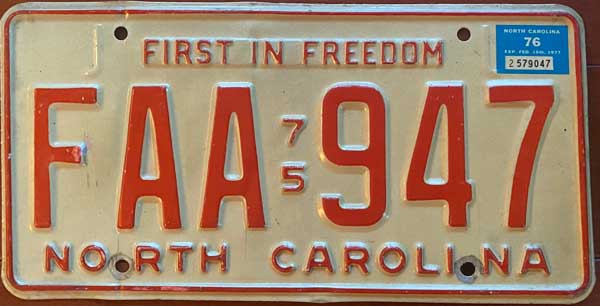 1975-1976 issue.
1975-1976 issue. 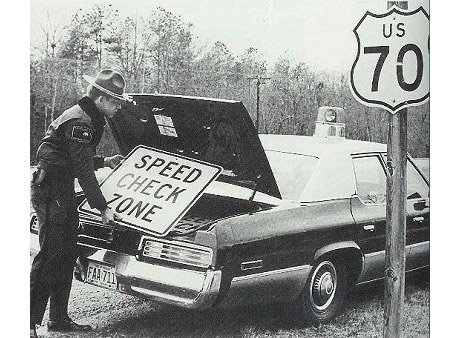 1975- FAA series for NCHP
1975- FAA series for NCHP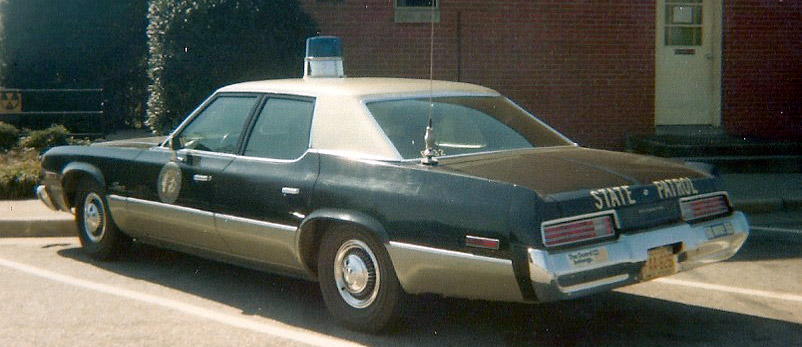
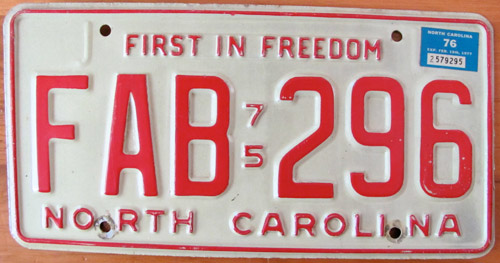 1975/1976 issue.
1975/1976 issue. 
For the first time in over 30 years, the NCHP launched an agency-specific license plate for all of its marked fleet in 1977.
The plate was the same red over reflective white color scheme as for the past two years and using the slogan FIRST IN FREEDOM. This time however, in lieu of recesses for validation decals in the upper corners, the year 1977 was embossed with the first two digits of the year occupying the top left corner of the plate and 77 occupying the right. The state name was still spelled-out in full along the bottom.
The plate had a registration number commencing with the Highway Patrol prefix of HP followed by a dash and then followed by a number up to three digits and by 1978, four digits.
HP-100 was reserved for the Colonel of the NCHP and the numbers descended in order of seniority from there.
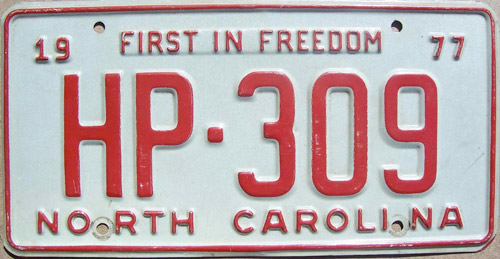 1977 issue.
1977 issue. 

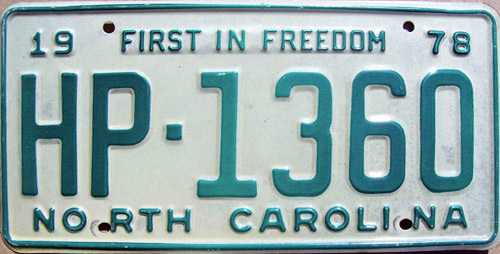 1978 issue.
1978 issue. 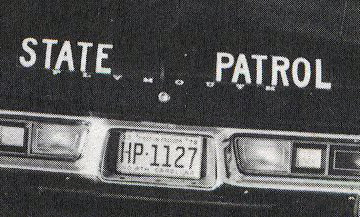 1978
1978
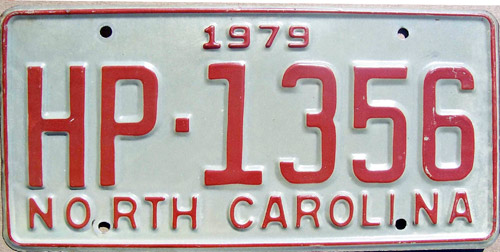 1979 issue.
1979 issue. 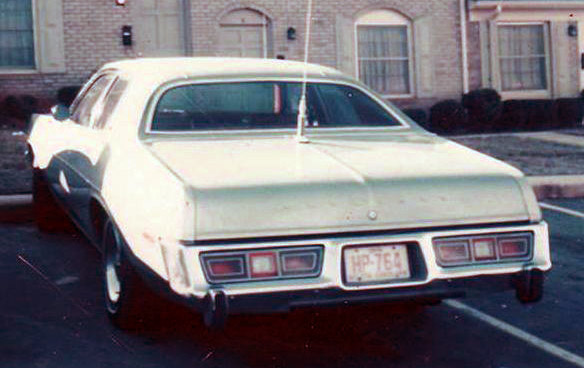 1979- HP-764 on unmarked NCHP Plymouth
1979- HP-764 on unmarked NCHP Plymouth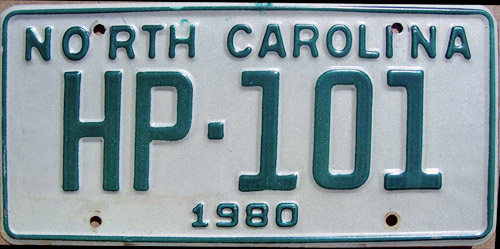 1980 issue. Green over reflective white.
1980 issue. Green over reflective white.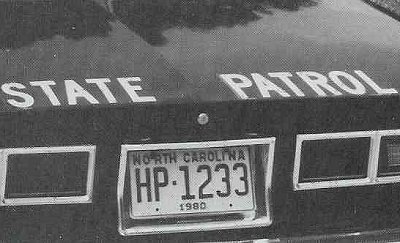 This plate was assigned to Trp Brenda Price
the NCHP's first ever female trooper who
successfully completed Basic Training School
and assigned for duty that year.
This plate was assigned to Trp Brenda Price
the NCHP's first ever female trooper who
successfully completed Basic Training School
and assigned for duty that year.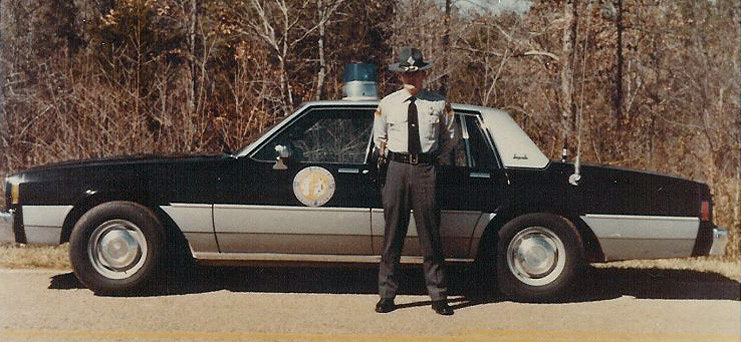
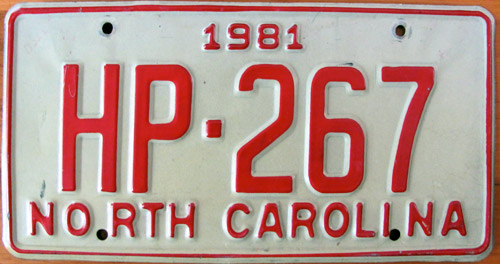 1981 issue. Red over reflective white.
1981 issue. Red over reflective white.
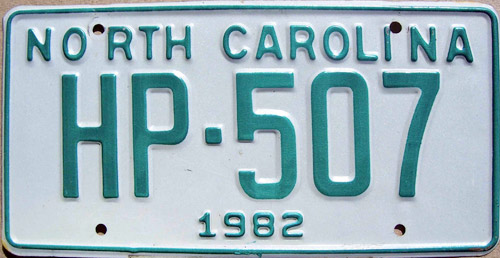 1982 issue.
1982 issue. 
In 1983 a major change in North Carolina license plates took place. A silkscreened red white and blue license plate was issued honoring the 80th anniversary of Orville and Wilbur Wright's historic first manned flight at Kitty Hawk NC. The plate had blue embossed characters over a reflective white background. An image of the Wright brothers' aircraft is centered at the top of the plate in blue with the shore grasses stretching the entire lower length of the plate in the same silkscreened color. The new slogan First in Flight was silkscreened in red between the upper mounting holes and the state name was silkscreened in a stylized red font along the bottom of the plate.
NCHP license plates continued to be issued annually with the first two digits of the year embossed in blue at the top left corner of the plate and the latter two numbers of the year embossed in blue at the top right corner.
The HP prefix continued for the NCHP until 1994 when the prefix SHP (State Highway Patrol) was substituted.
The North Carolina Highway Patrol is the only state law enforcement agency in the nation to continue issuing annual license plates for its motor vehicle fleet.
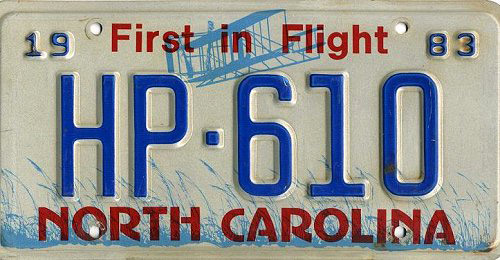 1983 issue.
1983 issue. 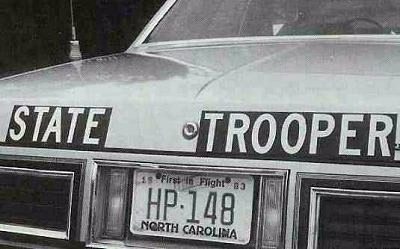 1983 did not only mark the launch of the first graphic NCHP license plate, but was also the year that the patrol car markings changed from STATE PATROL to STATE TROOPER
1983 did not only mark the launch of the first graphic NCHP license plate, but was also the year that the patrol car markings changed from STATE PATROL to STATE TROOPER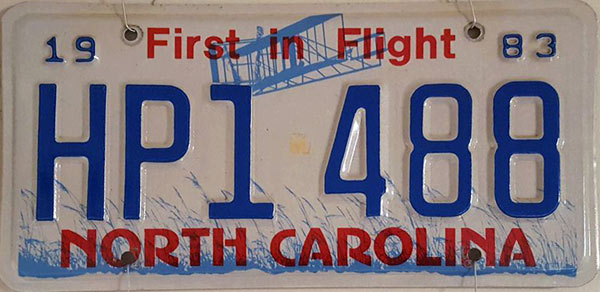 1983 unmarked car issue.
1983 unmarked car issue.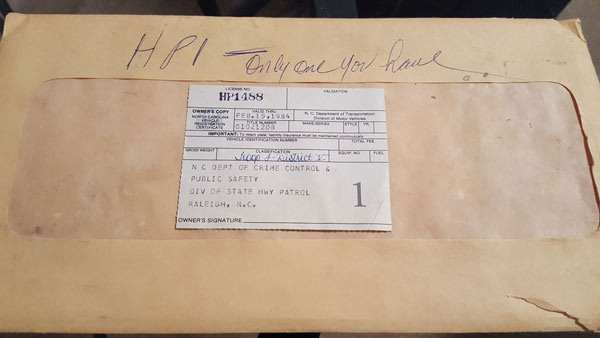
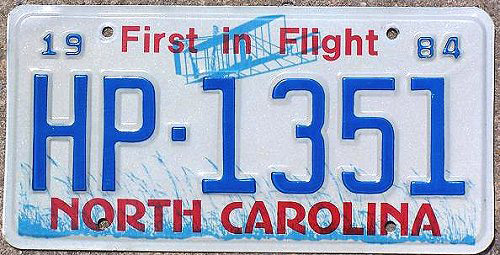 1984 issue.
1984 issue. 
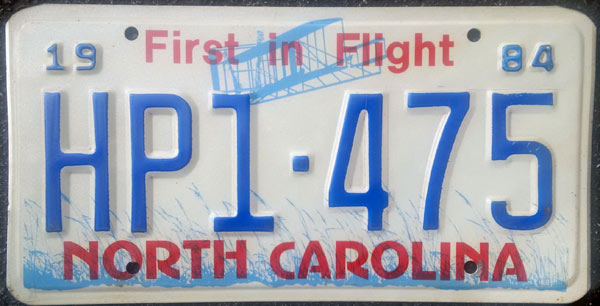 1984 unmarked car issue.
1984 unmarked car issue.
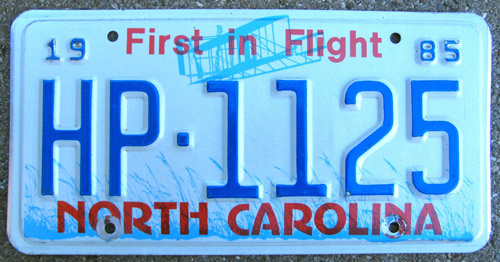 1985 issue.
1985 issue. 
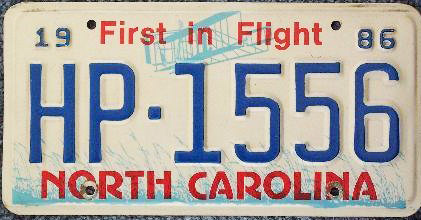 1986 issue.
1986 issue. 
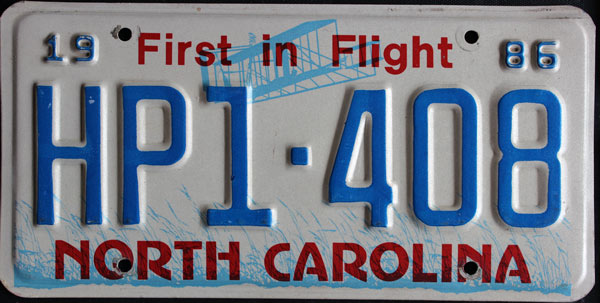 1986 unmarked car issue.
1986 unmarked car issue.
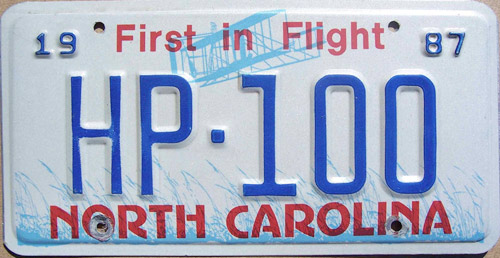 1987 issue.
1987 issue. 
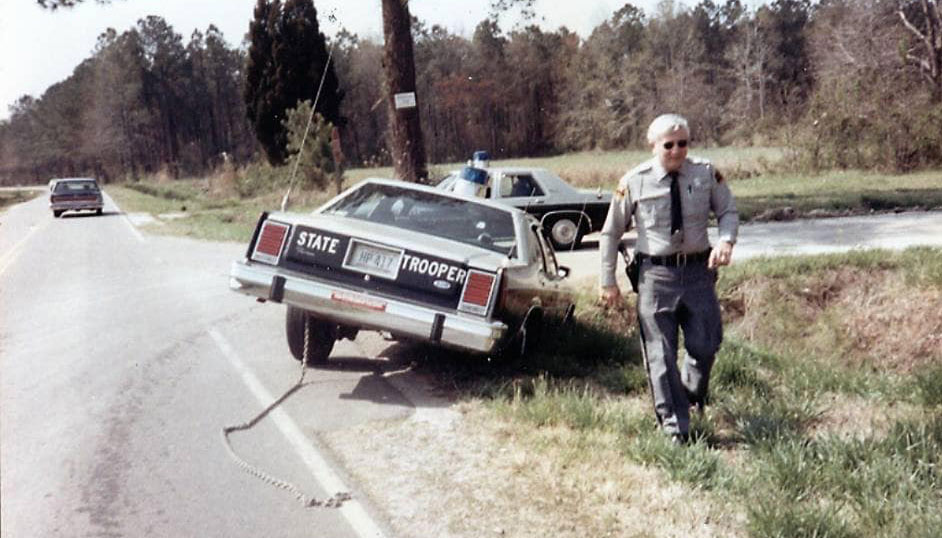 "Let's get this thing hooked-up before Sarge comes by..."
"Let's get this thing hooked-up before Sarge comes by..."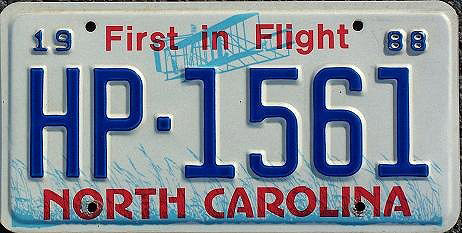 1988 issue.
1988 issue. 
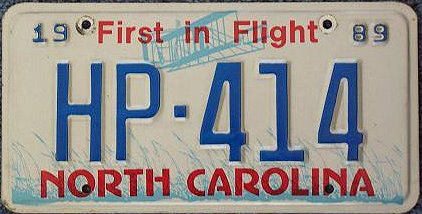 1989 issue.
1989 issue. 
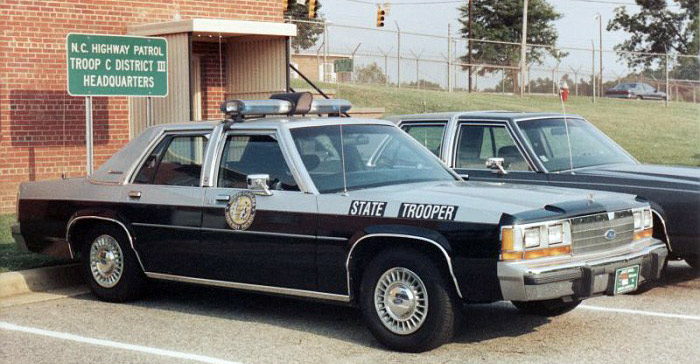
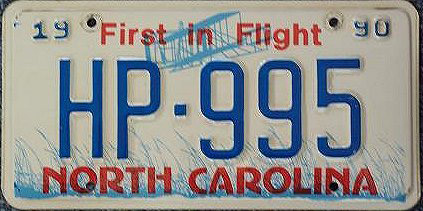 1990 issue.
1990 issue. 
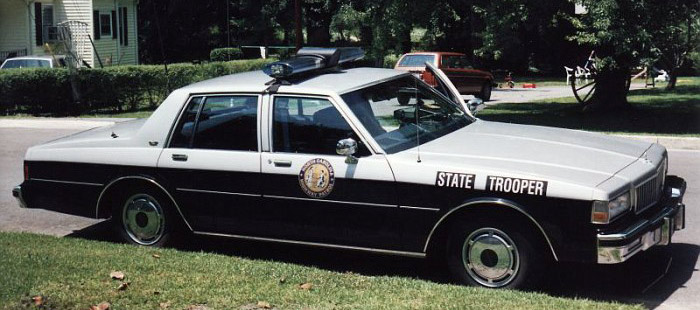
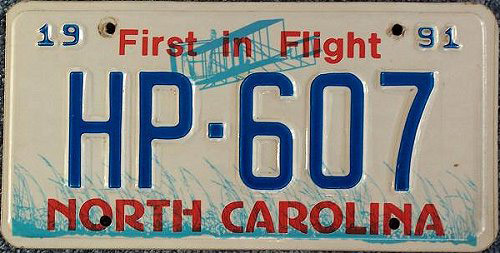 1991 issue.
1991 issue. 
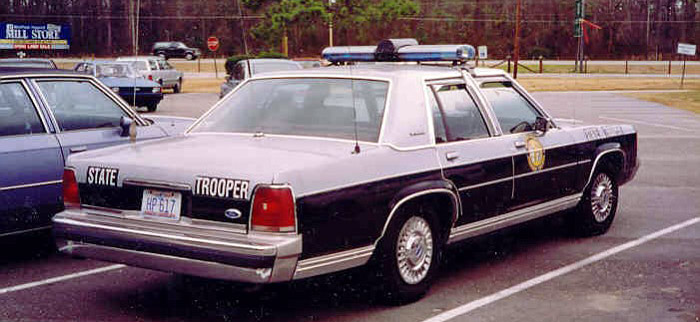
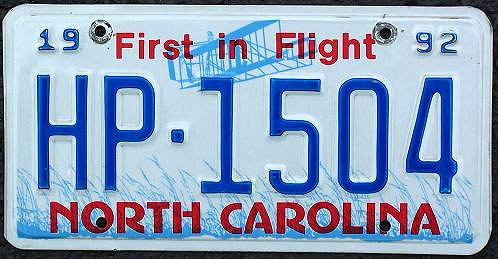 1992 issue.
1992 issue. 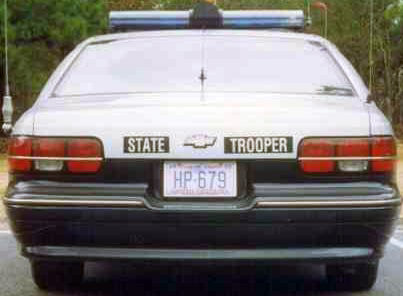 1992
1992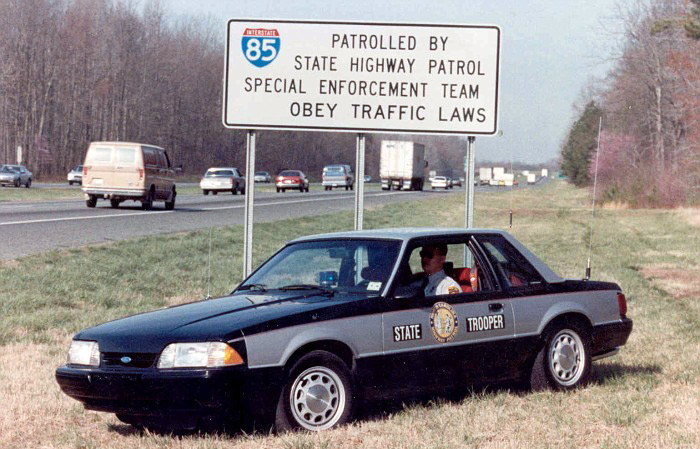
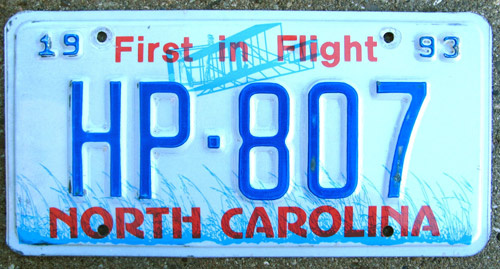 1993 issue.
1993 issue. 
 1994 issue.
1994 issue. 
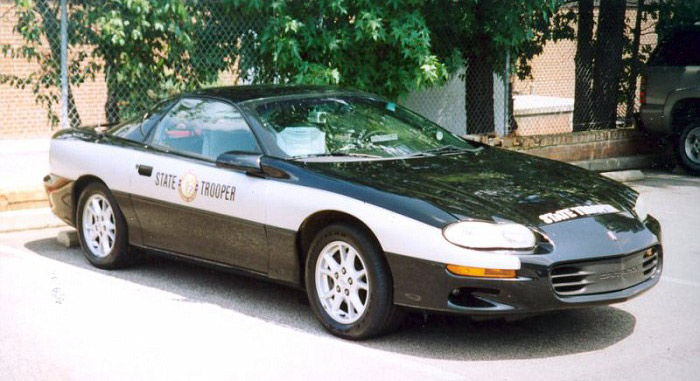
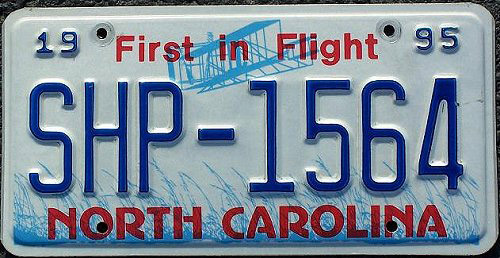 1995 issue.
1995 issue. 
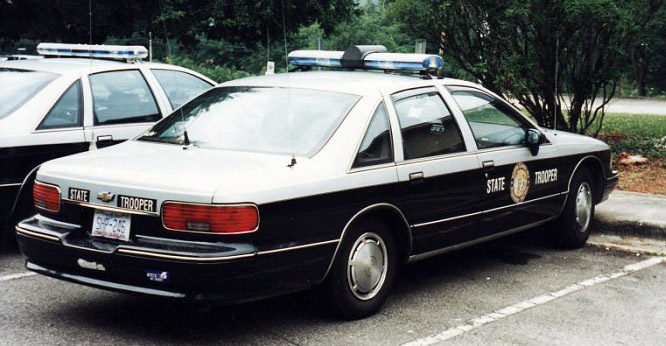
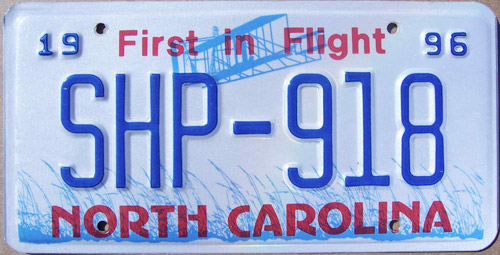 1996 issue.
1996 issue. 
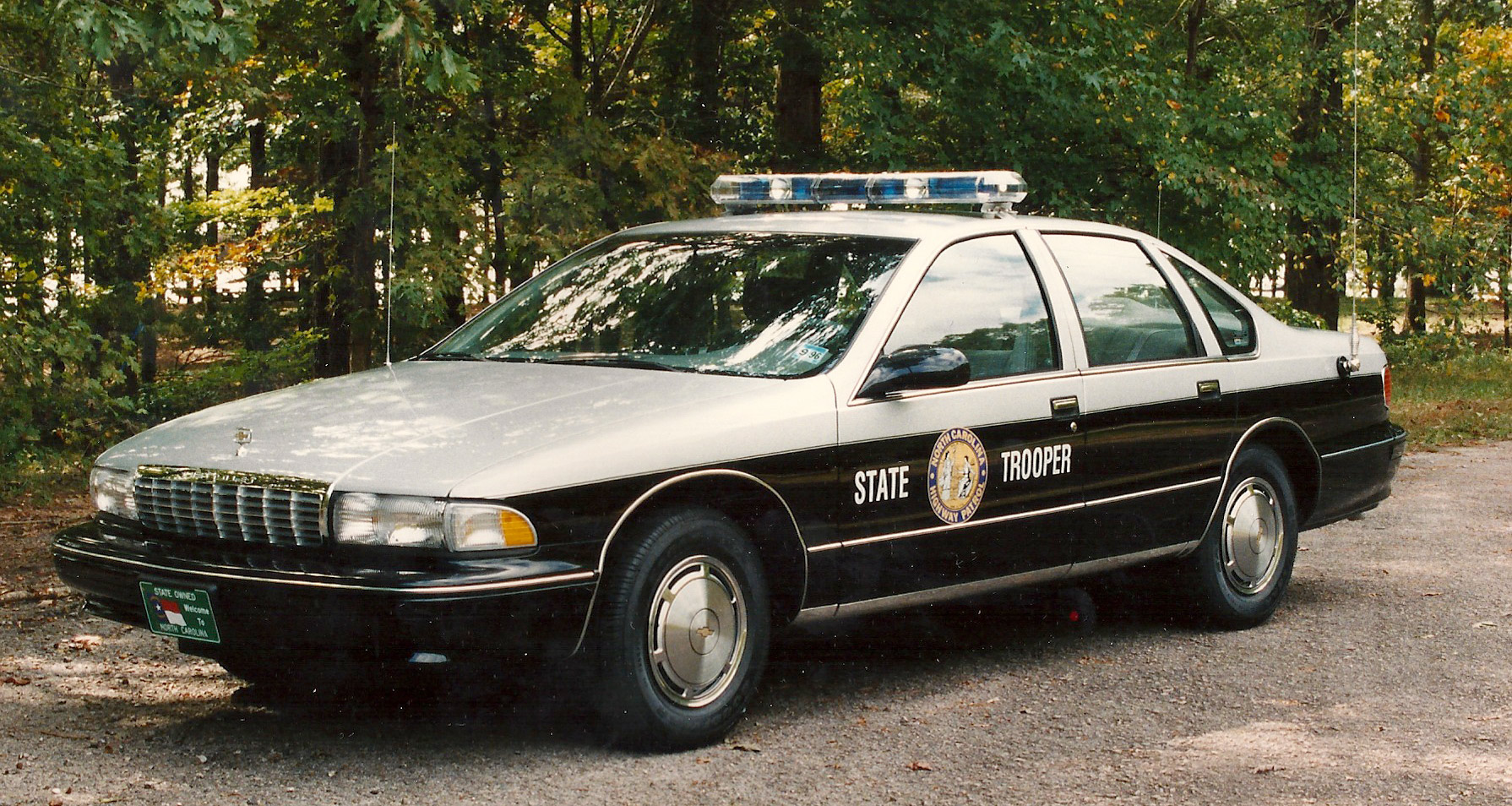
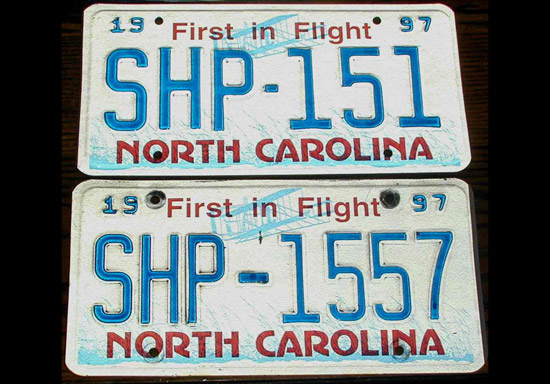 1997 issues. Showing the larger dies used for 3-digit numbers and thinner dies for four.
1997 issues. Showing the larger dies used for 3-digit numbers and thinner dies for four.
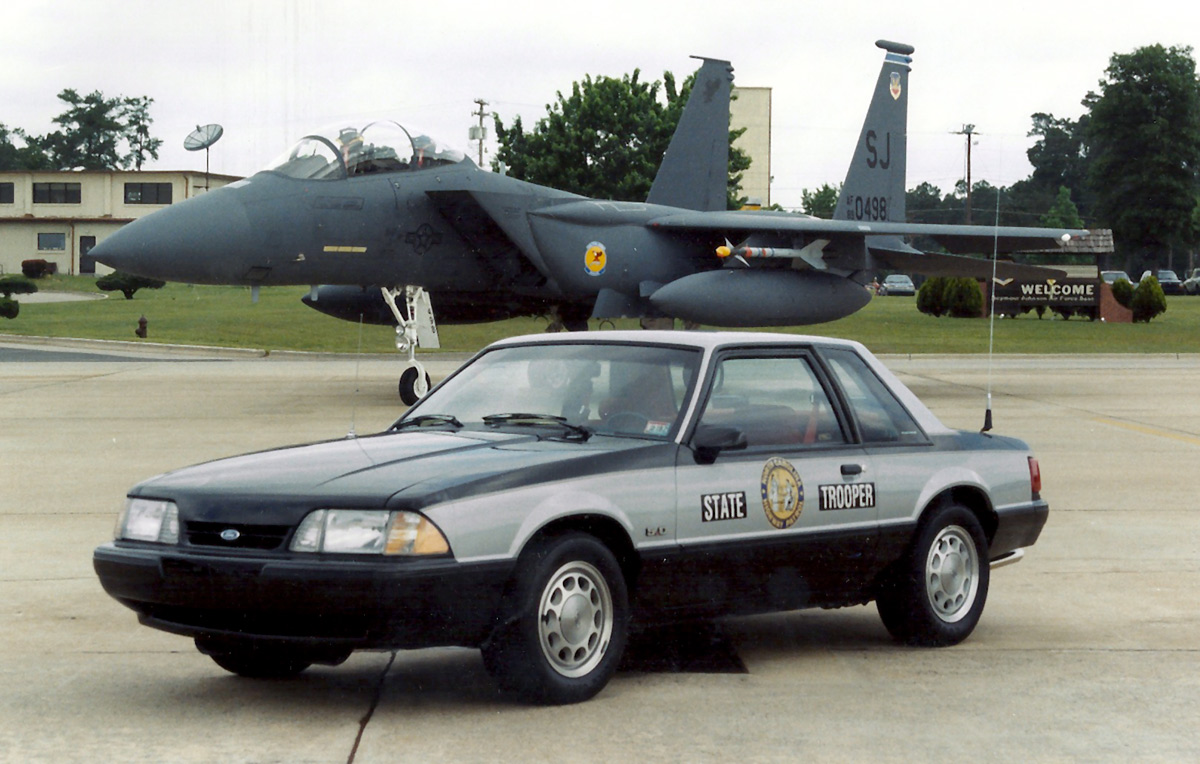
 1998 issue.
1998 issue. 
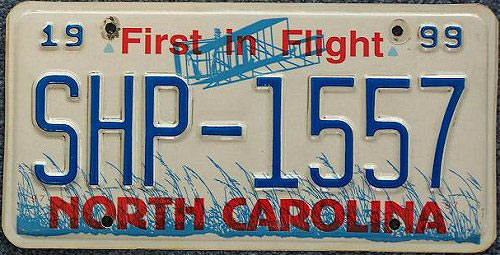 1999 issue.
1999 issue. 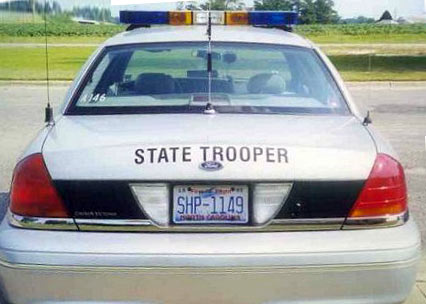 1999
1999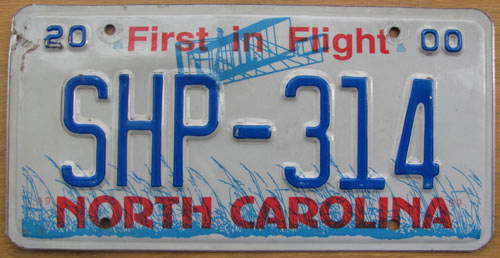 2000 issue.
2000 issue. 
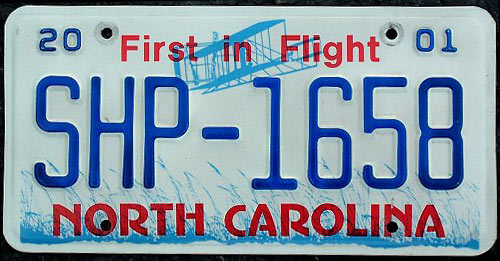 2001 issue.
2001 issue. 
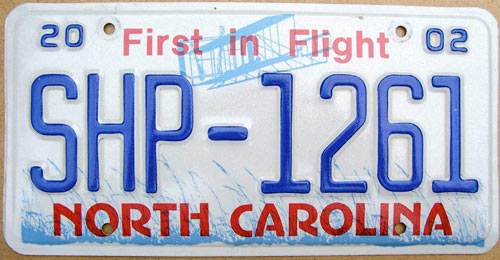 2002 issue.
2002 issue. 
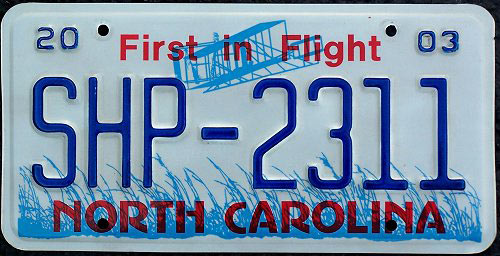 2003 issue.
2003 issue. 
 2004 issue.
2004 issue. 
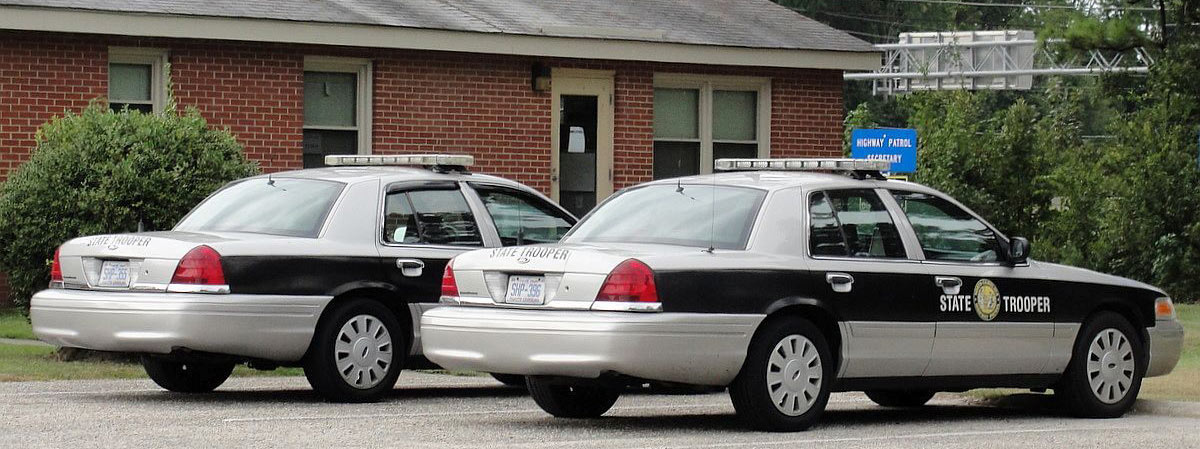
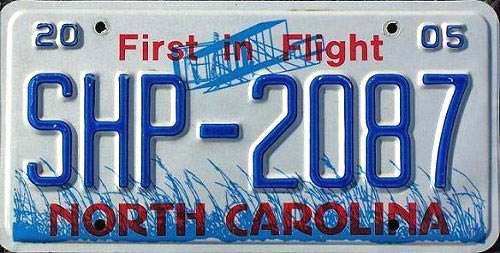 2005 issue.
2005 issue. 
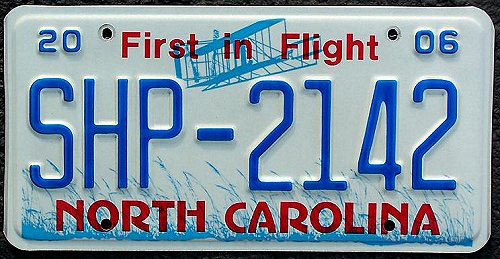 2006 issue.
2006 issue. 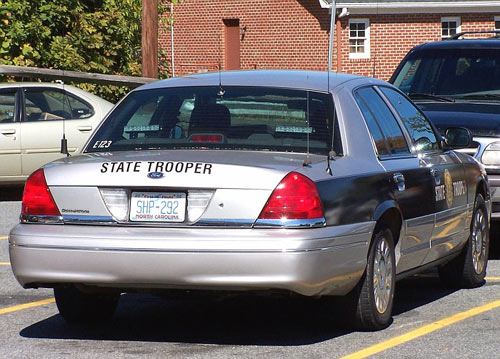 2006
2006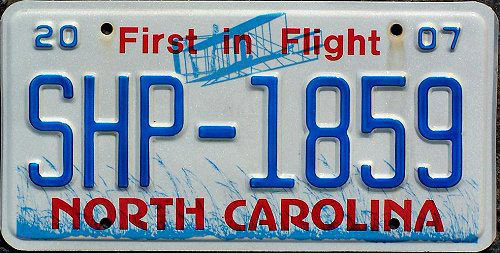 2007 issue.
2007 issue. 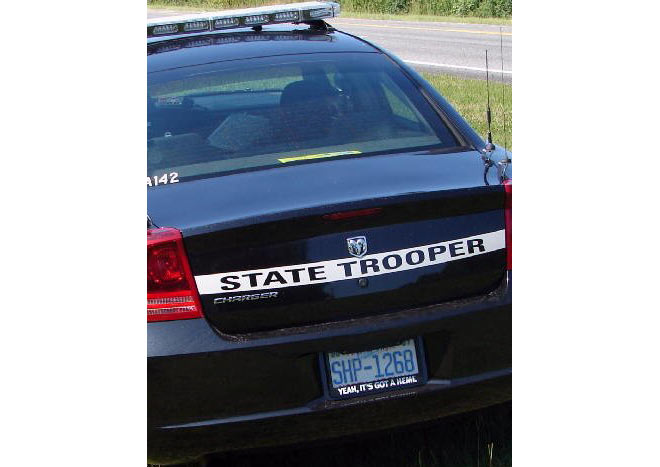 "YEAH, IT'S GOT A HEMI" license plate frame.
"YEAH, IT'S GOT A HEMI" license plate frame.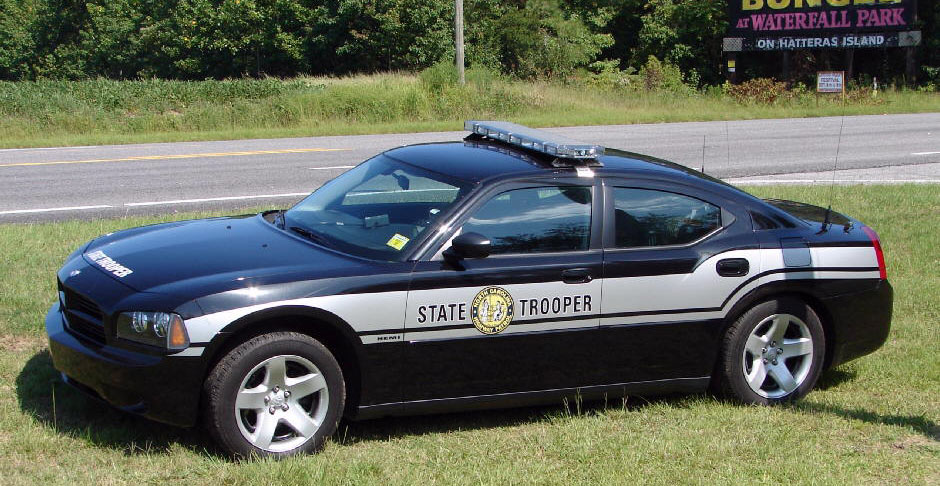
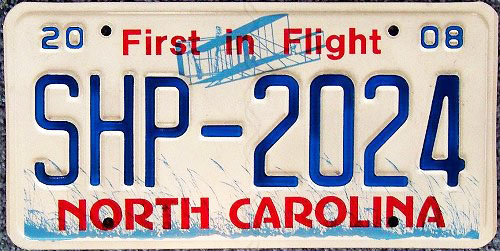 2008 issue.
2008 issue. 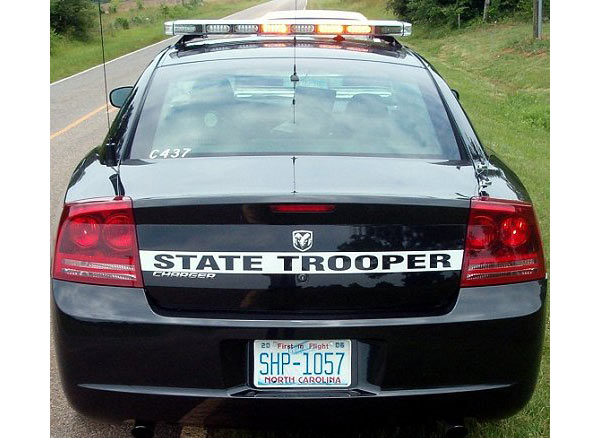 2008
2008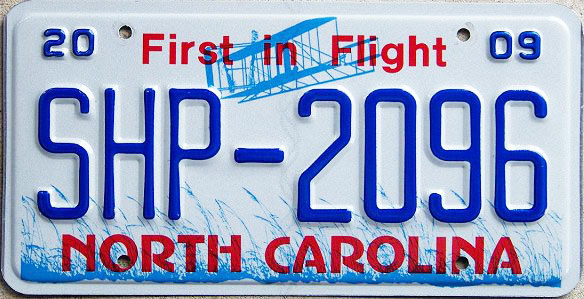 2009 issue.
2009 issue. 
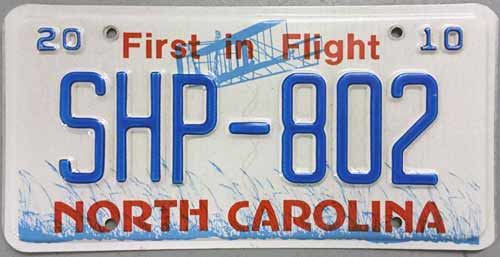 2010 issue.
2010 issue. 
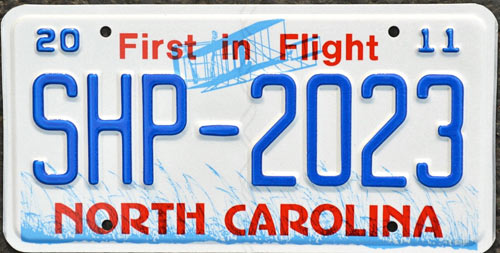 2011 issue.
2011 issue. 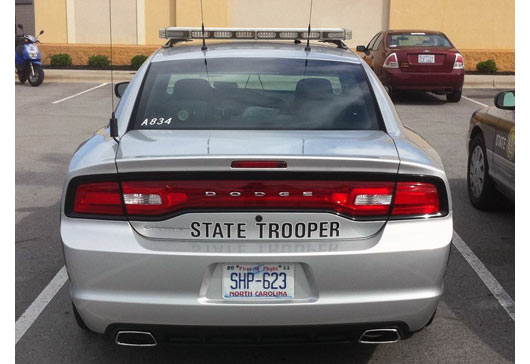 2011
2011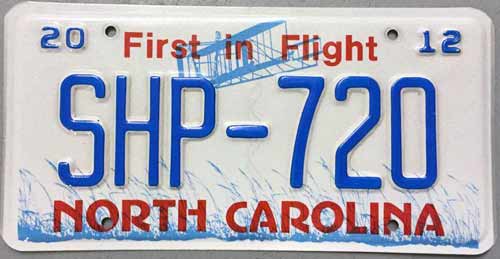 2012 issue.
2012 issue. 
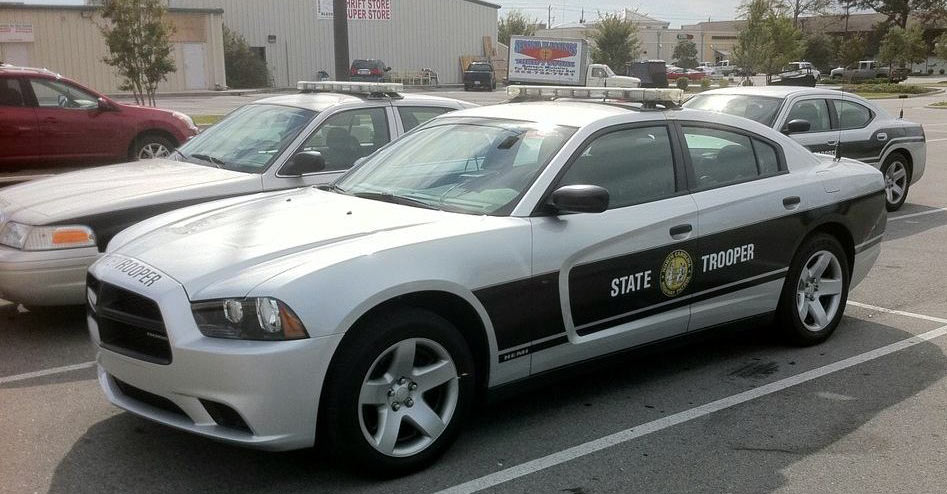
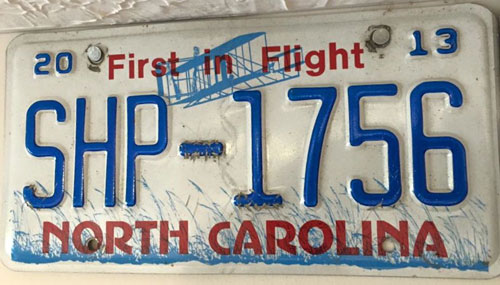 2013 issue.
2013 issue. 
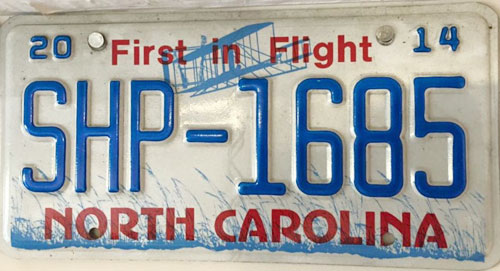 2014 issue.
2014 issue. 
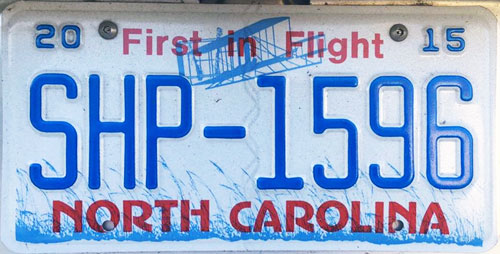 2015 issue.
2015 issue. 
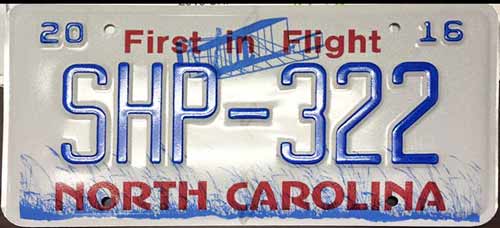 2016 issue.
2016 issue. 
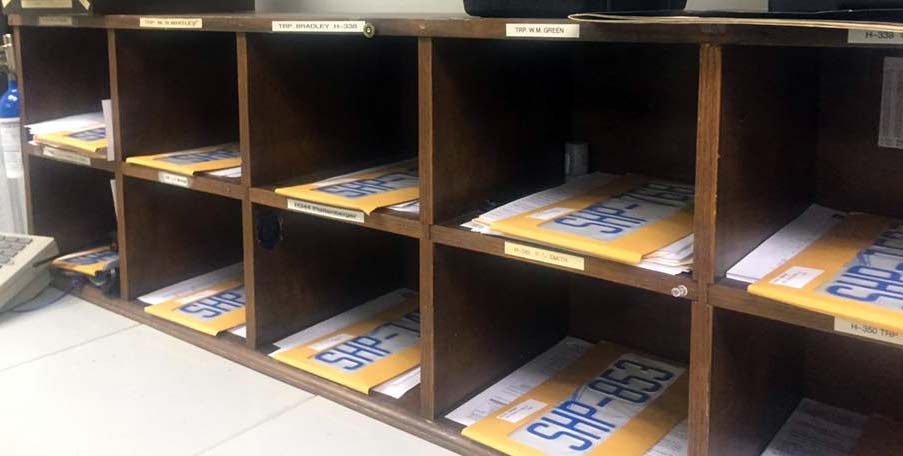 How North Carolina Troopers receive their license plates EVERY YEAR!
How North Carolina Troopers receive their license plates EVERY YEAR! 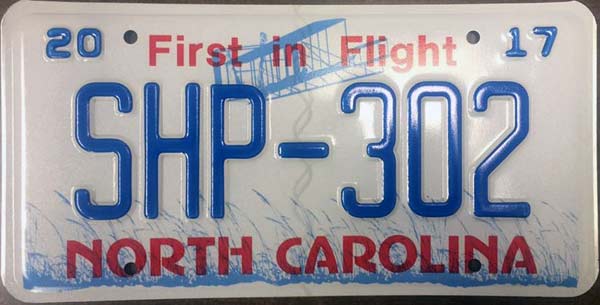 2017 issue.
2017 issue. 
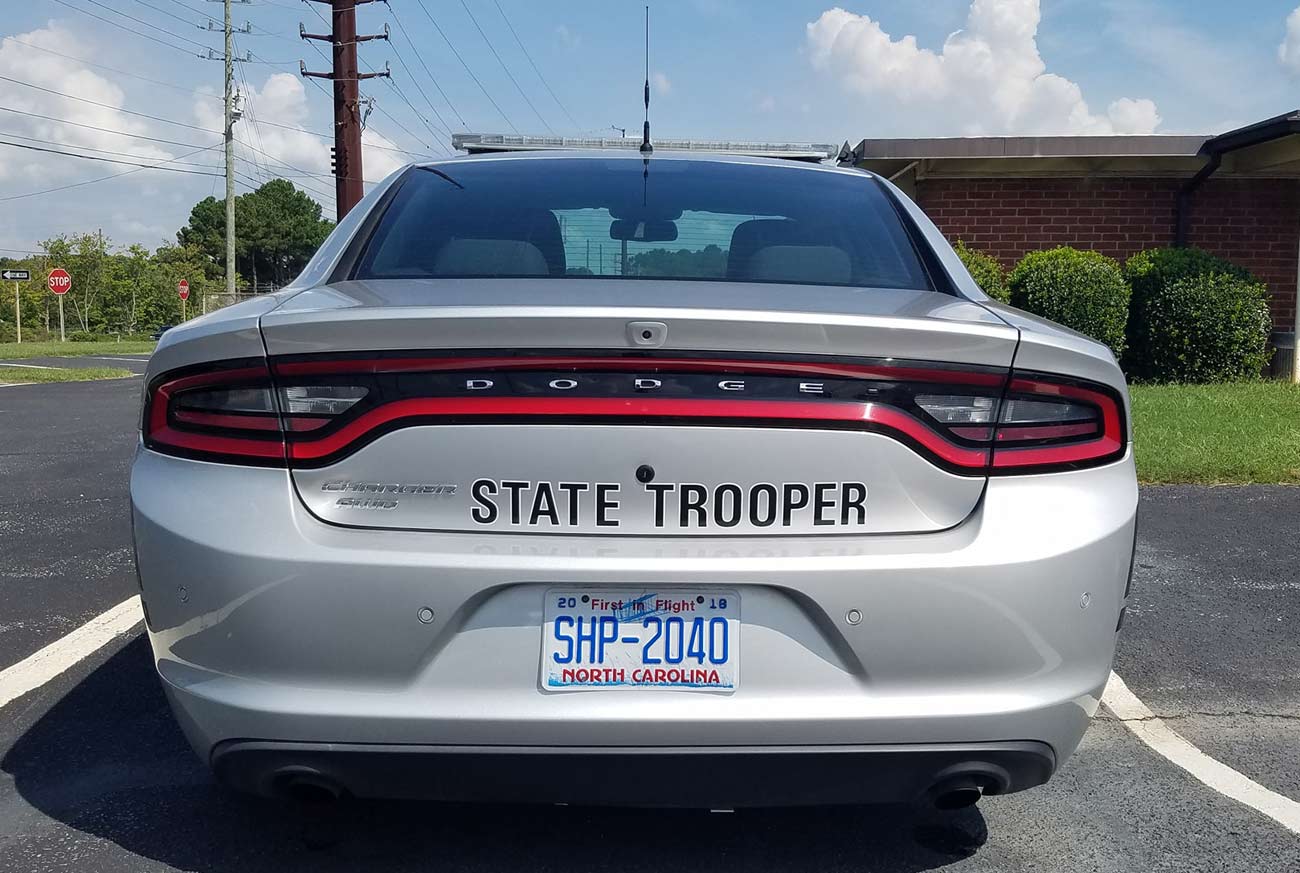 2018 issue. Blue and red over reflective white.
2018 issue. Blue and red over reflective white.In 2019, the North Carolina Highway Patrol celebrated its 90th Anniversary of service. As part of the commemoration, special souvenir license plates were made as souvenir keepsakes for all sworn and civilian staff which included their call number. The plates were made by the state and in the black over silver color scheme of the Patrol. The top portion of the plate has 20 and 19 embossed in the upper corners and 'Serving 1929 Since' inscribed in black silkscreen at the top center. At the left center portion of the plate, is the NCSHP 90th Anniversary roundel motif silkscreened in black, silver and blue. To the right of that is the personnel "call number" prefixed with either the Troop or Unit letter. At the bottom of the plate is the state name embossed in black along the entire span.
The plates were directed NOT to be used on NCSHP vehicles in lieu of the traditional First in Flight plates.
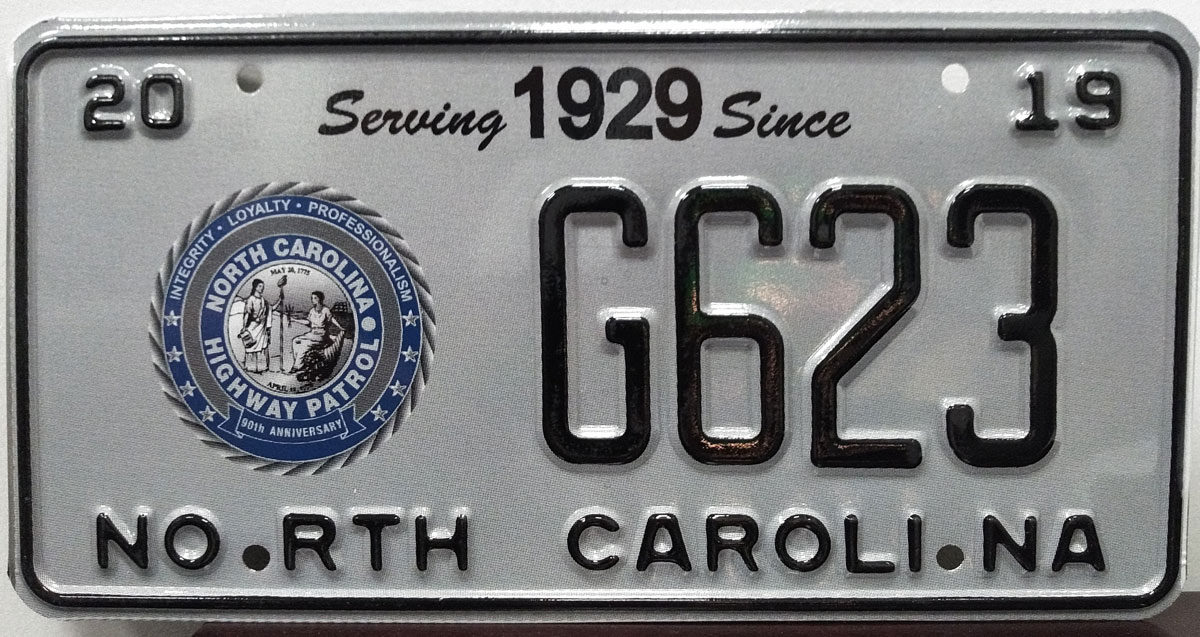 2019 Souvenir license plate commemorating the NCSHP's 90th Anniversary.
2019 Souvenir license plate commemorating the NCSHP's 90th Anniversary.  North Carolina Highway Patrol Academy staff with their X-prefixed 90th Anniversary souvenir plates.
North Carolina Highway Patrol Academy staff with their X-prefixed 90th Anniversary souvenir plates. 2020 issue.
2020 issue. 
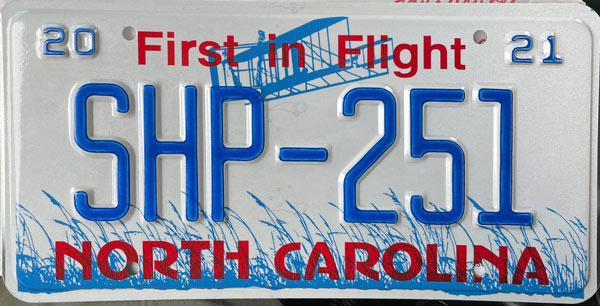 2021 issue.
2021 issue. 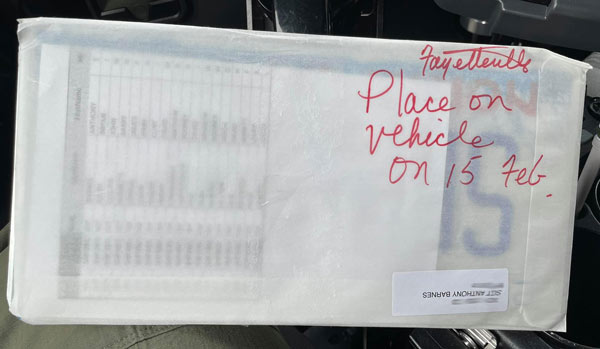 With instructions to affix the plate to the vehicle on February 15th.
With instructions to affix the plate to the vehicle on February 15th.Over the years since the 1970's, the North Carolina Highway Patrol has issued various types of official license plates to adorn the front of their patrol vehicles.
These early front plates are known as "flag tags". The plates are made on flat aluminum stock and screen painted. The colors are white characters over a green background. STATE OWNED occupies the top center of the plate. A large full color image of the North Carolina state flag occupies most of the center left field of the plate.
Welcome To is situated to the right of the flag in white as is the state name in full at the bottom center of the plate.
The early versions of this plate have a darker green background and are non-reflective.
Newer versions use a reflective green background.
Since the early 2000's other front plate choices were launched, as can be seen below.
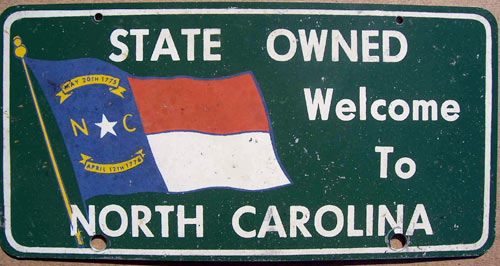 Circa 1970-1990's NCHP "flag tag" front plate.
Circa 1970-1990's NCHP "flag tag" front plate.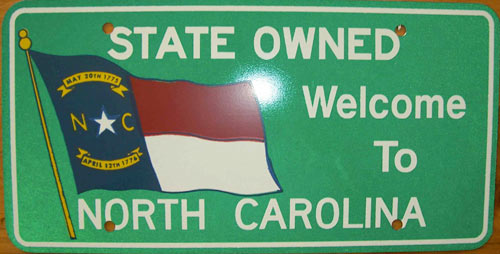 1990's-2000 NCHP "flag tag" front plate.
1990's-2000 NCHP "flag tag" front plate.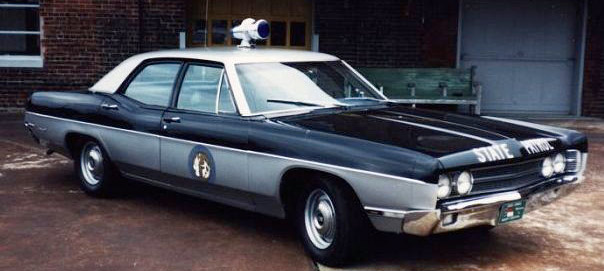
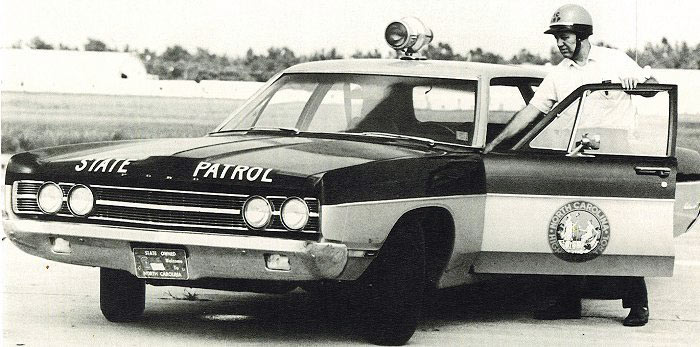
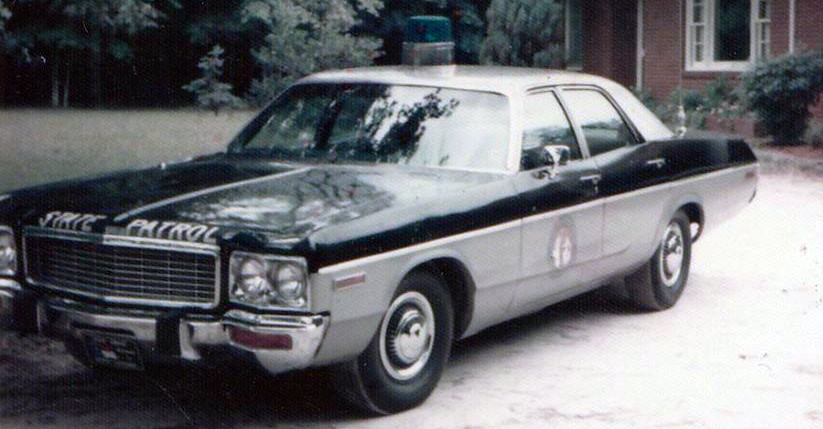
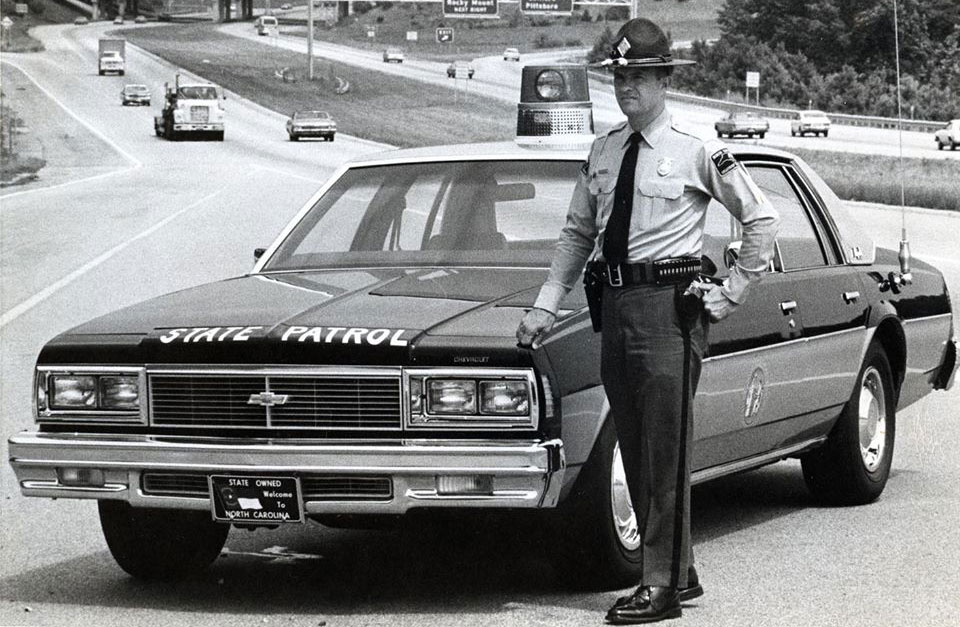
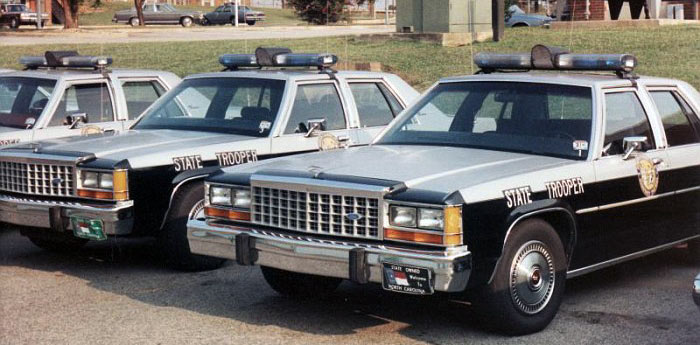
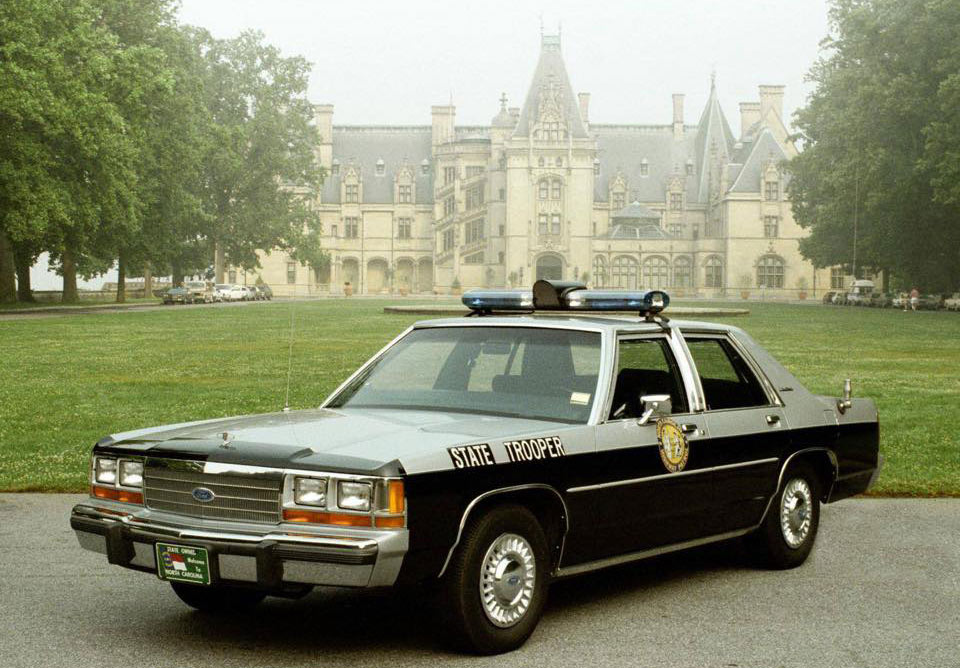 (Courtesy Garrett Green)
(Courtesy Garrett Green)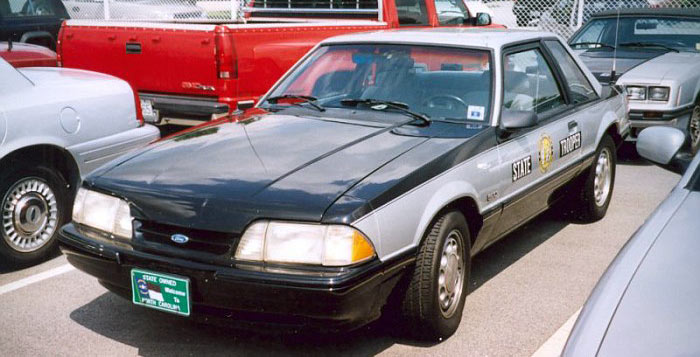
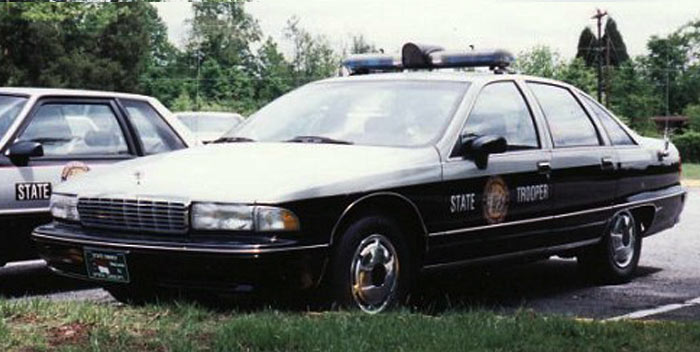
 SSP Ford Mustang
SSP Ford Mustang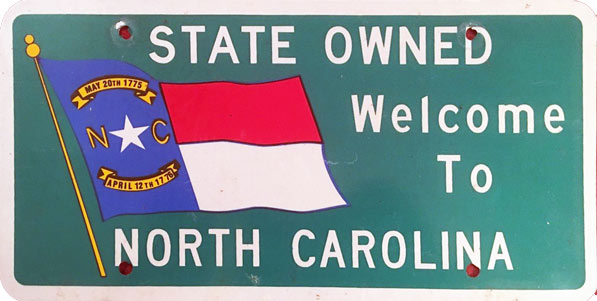 Circa late 1990's-Early 2000's "flag tag".
Circa late 1990's-Early 2000's "flag tag".
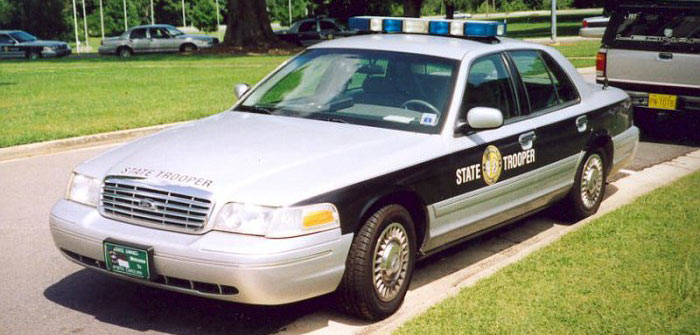
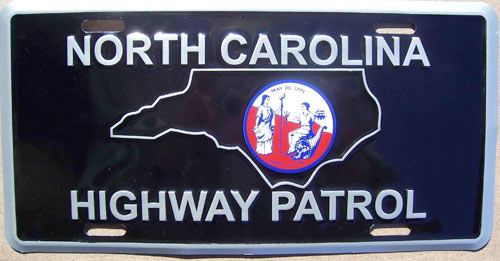 2000-era front "booster" plate in silver trim.
2000-era front "booster" plate in silver trim.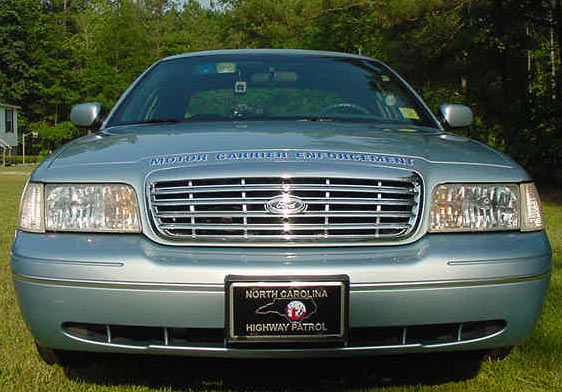
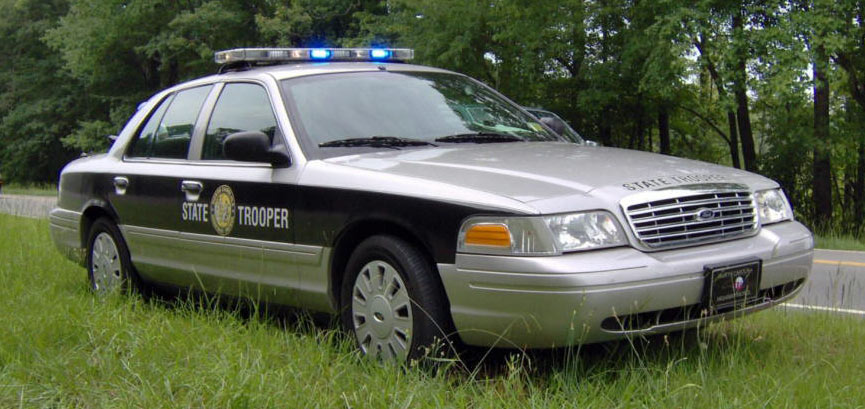
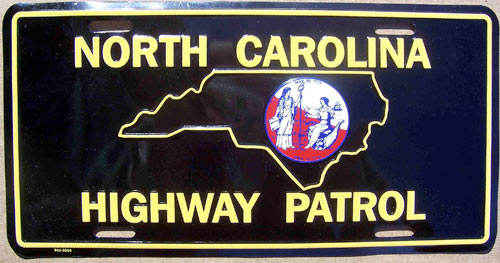 2000-era front "booster" plate in yellow-gold trim.
2000-era front "booster" plate in yellow-gold trim.
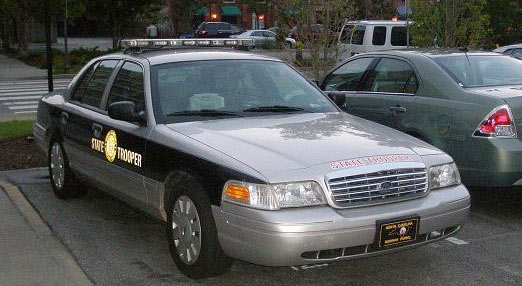
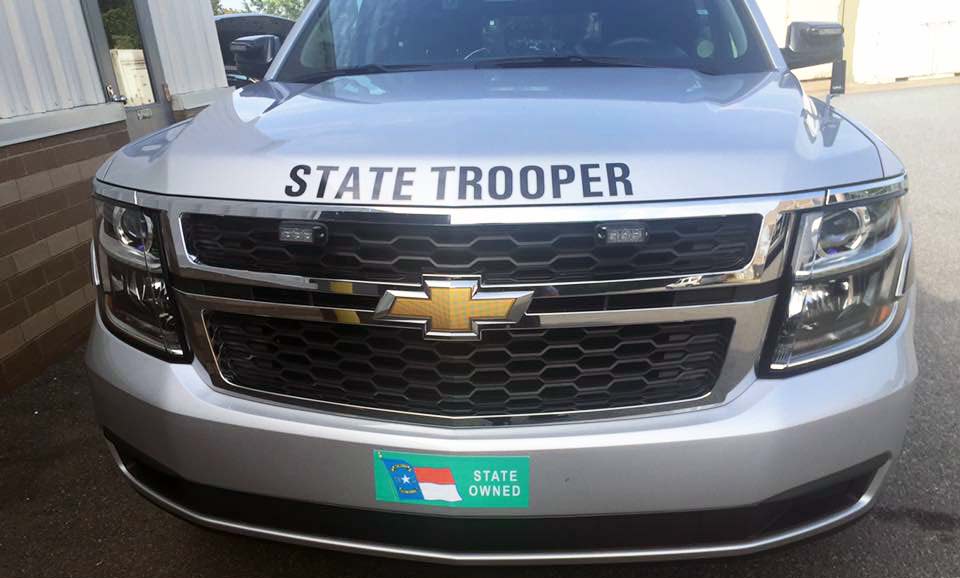 STATE OWNED decal now being used in lieu of license plate (2016).
STATE OWNED decal now being used in lieu of license plate (2016). 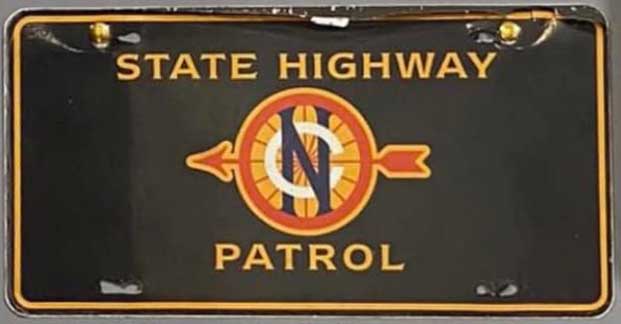 "Retro booster" souvenir plate.
"Retro booster" souvenir plate.
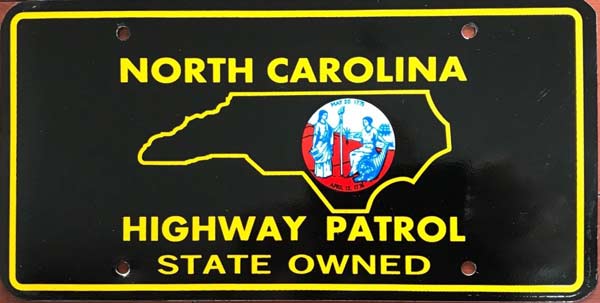 2018-Current issue front plate.
2018-Current issue front plate.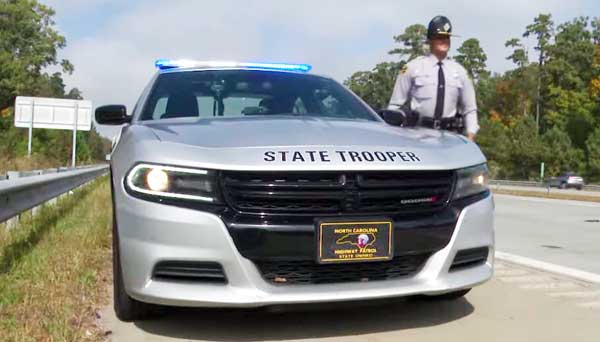 New booster in use.
New booster in use. 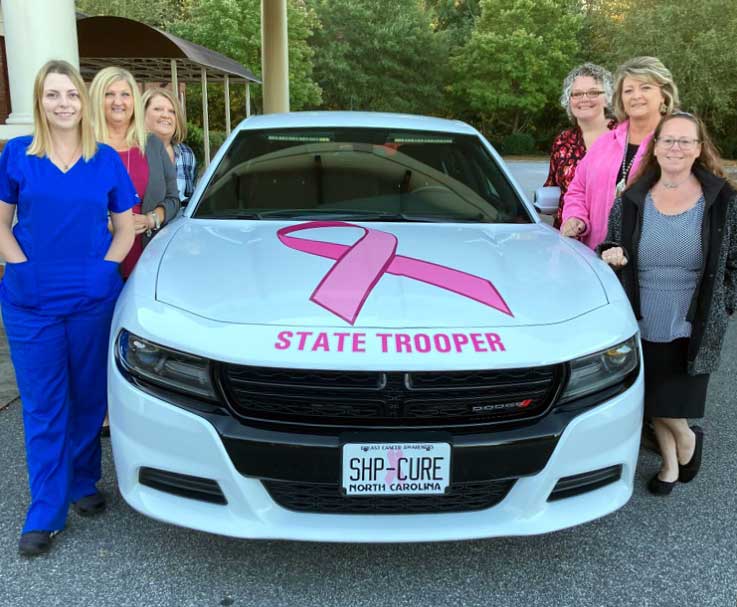 2022 Breast Cancer Awareness booster plate.
2022 Breast Cancer Awareness booster plate.The usage of motorcycles in the early days of the North Carolina State Highway Patrol is virtually unknown.
A 1936 NCHP motorcycle license plate number HP53 was discovered several years ago. The plate had the format and color scheme of the contemporary regular motorcycle plates of the time. Embossed steel measuring 7 1/4" x 2 7/8" in yellow-green over black.
A 1937 version with the same HP53 number exists in the orange over black color scheme of that year.
No other NCHP motorcycle license plates are known until the current issue was launched in 2005.
The newest NCHP motorcycle license plate is a standard 7" x 4" embossed aluminum plate. It is colored blue over reflective white. N.C. is embossed at the top center of the plate. The prefix HPMU (Highway Patrol Motor(cycle) Unit) is followed by a small dash and the assignment number.
The plate is validated by means of an annual expiry decal which features the plate number printed in the registration field at the bottom of the decal. This decal is affixed at the top right portion of the plate.
A month decal is affixed to the left portion of the plate with a 12 (December) expiry.
 1936 motorcycle issue.
1936 motorcycle issue.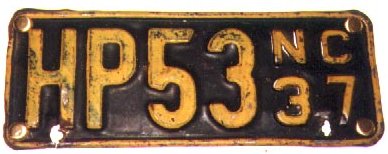 1937 motorcycle issue.
1937 motorcycle issue. 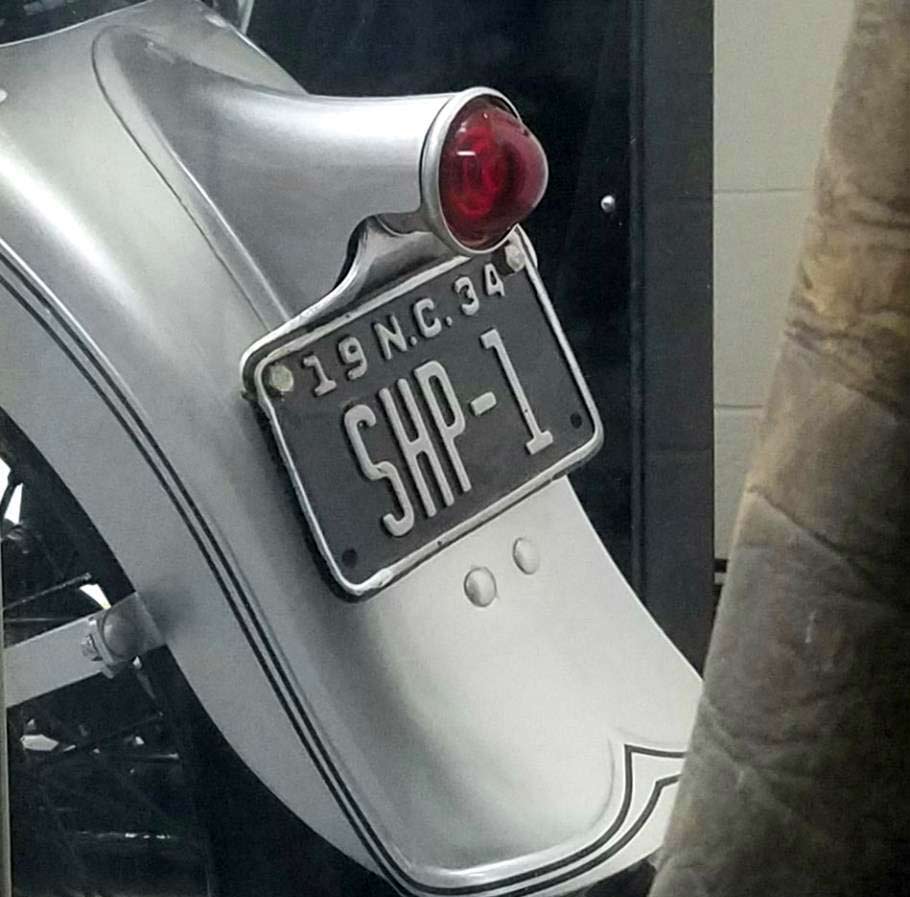 1934 REPRODUCTION for NCSHP restored museum motorcycle.
1934 REPRODUCTION for NCSHP restored museum motorcycle.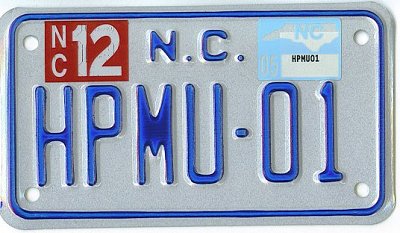 2005-current issue motorcycle plate.
2005-current issue motorcycle plate.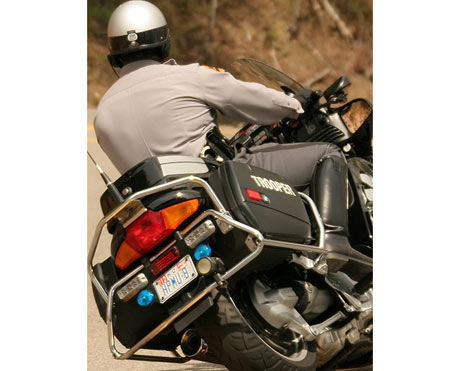
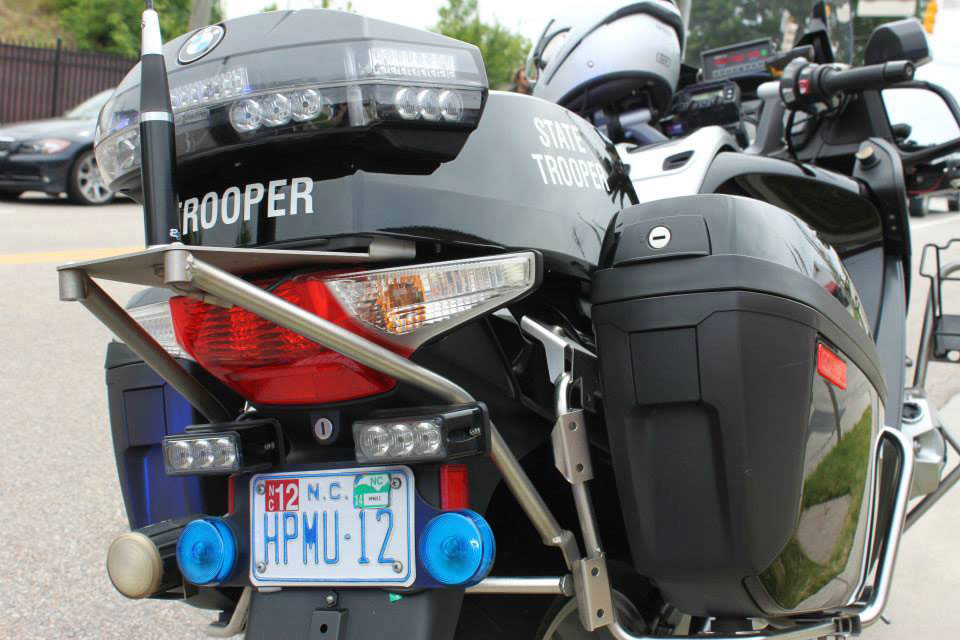
The North Carolina Highway Patrol has released a variety of sanctioned "booster plates" aside from the "flag tags" outlined further above. There have also been a number of non-sanctioned booster plates that have also made their way onto the front ends of NCHP vehicles. Booster license plates to commemorate Anniversary milestones were released for the 50th, 60th, 70th and 75th, 80th, 85th and 90th Anniversaries thusfar.
There have also been some locally-generated booster plates, some centering on Troop or unit specialization showcasing.
There have also been a number of NCHP Association booster plates developed as well.
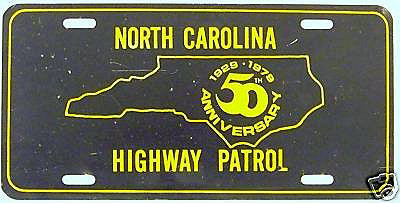 1979 50th Anniversary booster license plate.
1979 50th Anniversary booster license plate.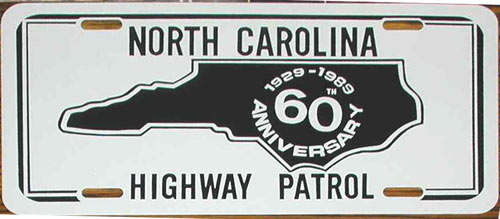 1989 60th Anniversary booster license plate.
1989 60th Anniversary booster license plate.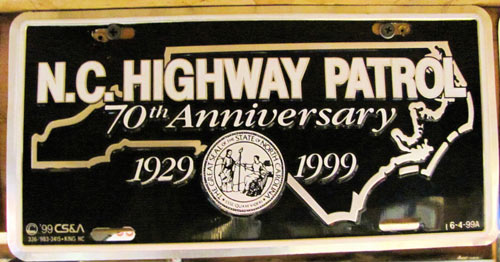 1999 70th Anniversary booster
1999 70th Anniversary booster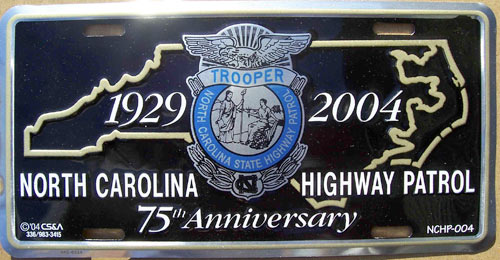 2004 75th Anniversary booster
Embossed thin aluminum
2004 75th Anniversary booster
Embossed thin aluminum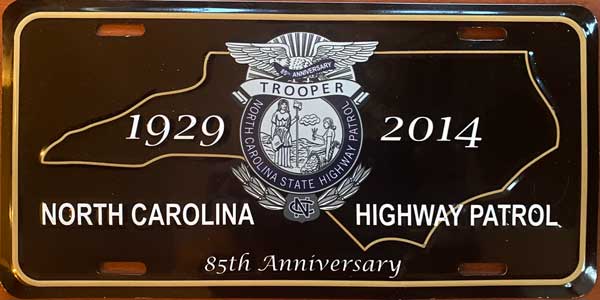 2014 85th Anniversary booster
2014 85th Anniversary booster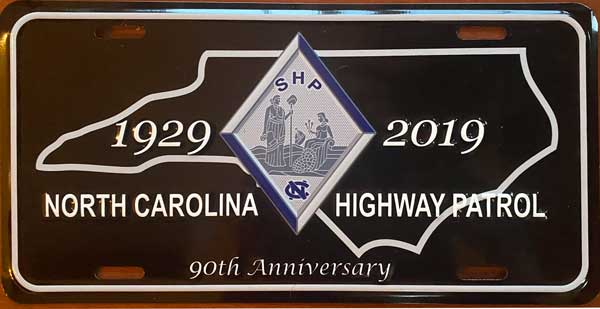 2019 90th Anniversary booster
2019 90th Anniversary booster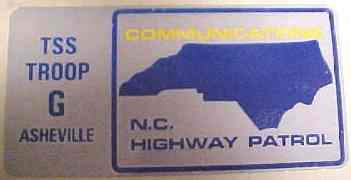 Troop G (Asheville) Communications booster plate.
Troop G (Asheville) Communications booster plate.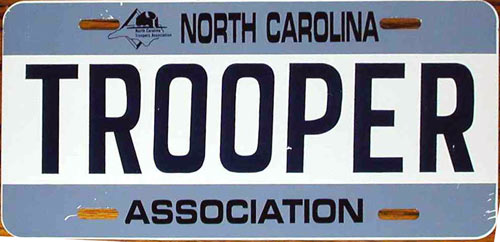 North Carolina Trooper Association booster plate.
North Carolina Trooper Association booster plate.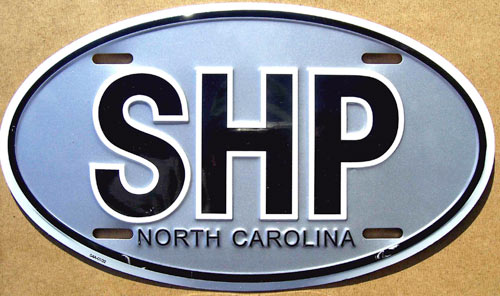 Oval NC SHP booster plate.
Oval NC SHP booster plate.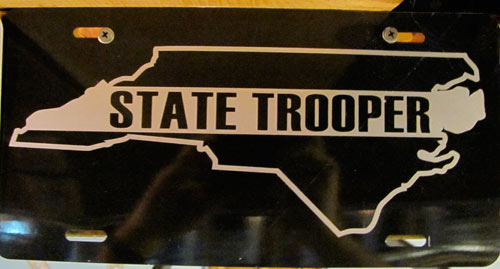 NC STATE TROOPER booster plate.
NC STATE TROOPER booster plate.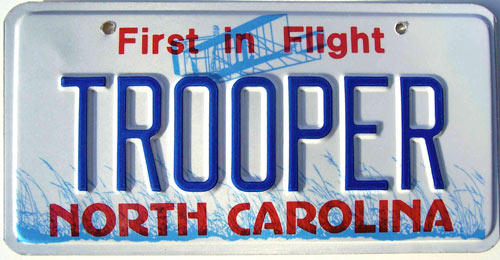 National Troopers Coalition souvenir plate. Embossed aluminum.
National Troopers Coalition souvenir plate. Embossed aluminum.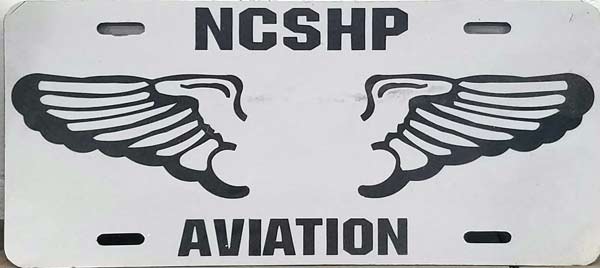 Aviation Unit booster plate.
Aviation Unit booster plate.Retirees of the North Carolina Highway Patrol can obtain special graphic license plates for their private vehicles indicating their retirement from service with the NCHP.
The plates follow the same red/white/blue graphic motif as the in-service plates used by the NCHP since 1983.
The emblem of the NCHP appears at the far left of the plate and SHP-RETIRED in black on the lower outter circumference of the emblem. A number up to four digits is embossed in the center and HP is silkscreened in blue "stacked" to the right side of the plate.
The plates are validated annually with month and year decals assigned to the owner.
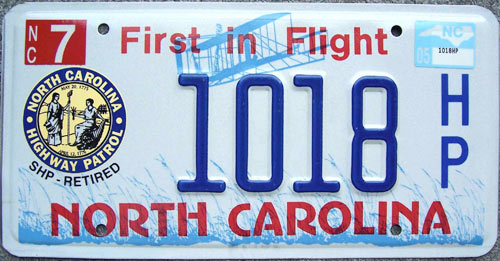 2005-2015 issue- NCHP Retiree plate.
2005-2015 issue- NCHP Retiree plate. 
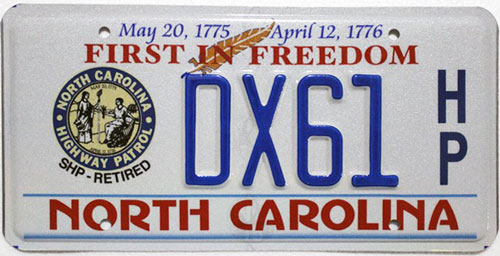 2015-Current issue- NCHP Retiree plate.
2015-Current issue- NCHP Retiree plate. 
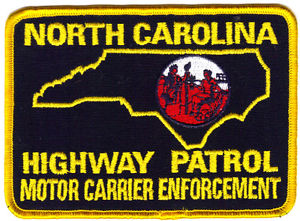 The primary purpose of the State Highway Patrol Motor Carrier Enforcement Administration Section is to promote highway safety, enforce all state and federal laws regulating highway and commercial vehicle operations resulting in reduction in crashes, injuries, and fatalities involving large trucks and buses.
The primary purpose of the State Highway Patrol Motor Carrier Enforcement Administration Section is to promote highway safety, enforce all state and federal laws regulating highway and commercial vehicle operations resulting in reduction in crashes, injuries, and fatalities involving large trucks and buses.
Troopers who perform Motor Carrier Enforcement duties ensure that all modes of travel, including commercial motor vehicles, are consistently monitored in order to improve highway safety.
The Motor Carrier Enforcement section is committed to reducing the rate of commercial motor vehicle-involved fatal collisions and fatalities. To accomplish this, the Motor Carrier Enforcement Section is committed to:
Increase commercial motor vehicle enforcement presence statewide.
Perform commercial vehicle enforcement activities to reduce commercial vehicle collisions of all types.
Conduct special enforcement projects to implement the "Motor Carrier New Entrant" program.
Conduct motor carrier audits.
Increase the frequency of driver and vehicle inspections.
Enforce serious commercial driver's license (CDL) violations.
Patrol the highways of the state to include low tonnage and posted bridge roads to detect overweight vehicle violations.
Monitor commercial motor vehicle traffic to ensure compliance with the federal bridge and axle tolerance laws.
Operate the state's permanent weigh stations.
Perform portable weighing activities.
Monitor commercial motor vehicle traffic to interdict motor fuels tax evasion.
The earlier NCMCE vehicles ran standard State Owned (PERMANENT) license plates on the rear of the vehicle only.
There are not many good/clear photos of these vehicles and the license plate use during those earlier years, so we can use your help to scrounge for some.
In more recent years now, NC Motor Carrier Enforcement vehicles use NCHP license plates and the same seniority sequence for plate numbering.
Despite the seniority number on the SHP prefixed plates used by the Motor Carrier Officers, their radio call numbers differ from regular NC Troopers by using a 9 designation. For example, a regular Trooper operating out of Troop E could have the radio call sign of E-345. The Motor Carrier unit in that area would be E-945. (Thanks to David Beal for this information).
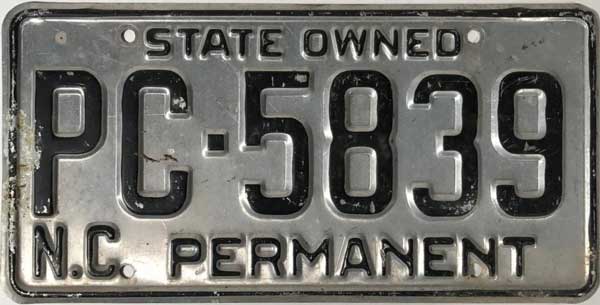 1963-1966 State Exempt issue.
1963-1966 State Exempt issue.
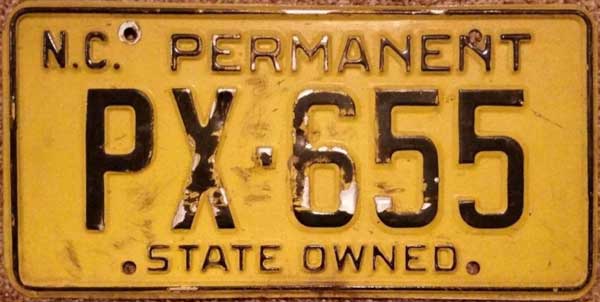 1972-1973 State Exempt issue.
1972-1973 State Exempt issue.
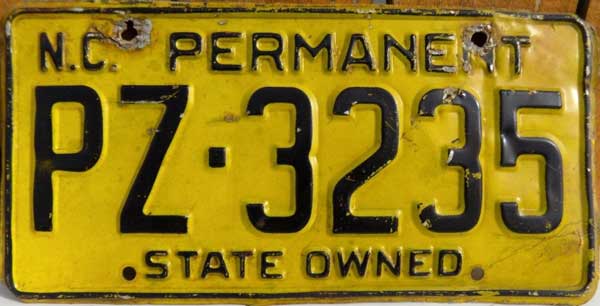 1974 State Exempt issue.
1974 State Exempt issue.
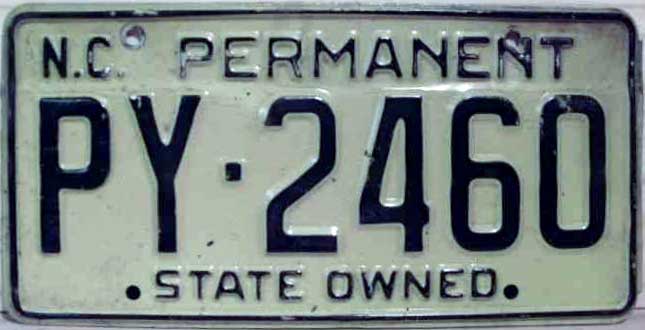 Late 1970's-c.1984 State Exempt issue
Late 1970's-c.1984 State Exempt issue
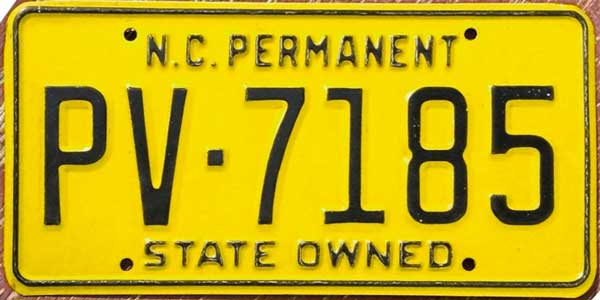 c.1980's State Exempt issue
c.1980's State Exempt issue
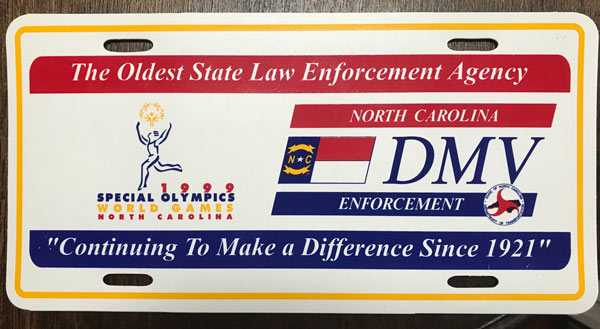 1999 NCDMV Enforcement Booster- Special Olympics
1999 NCDMV Enforcement Booster- Special Olympics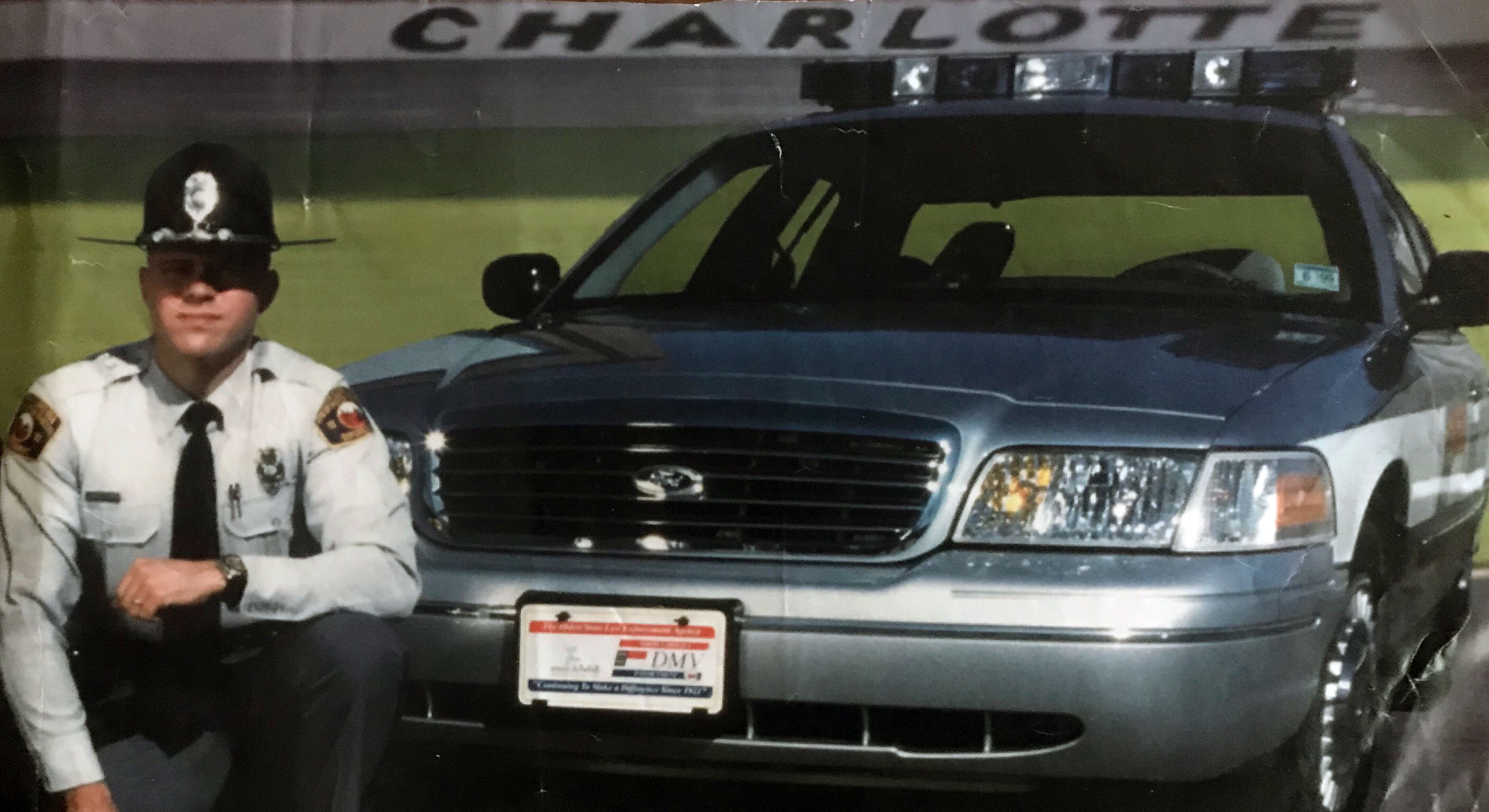 Displayed on front of NCDMV Enforcement vehicles in 1999
Displayed on front of NCDMV Enforcement vehicles in 1999 